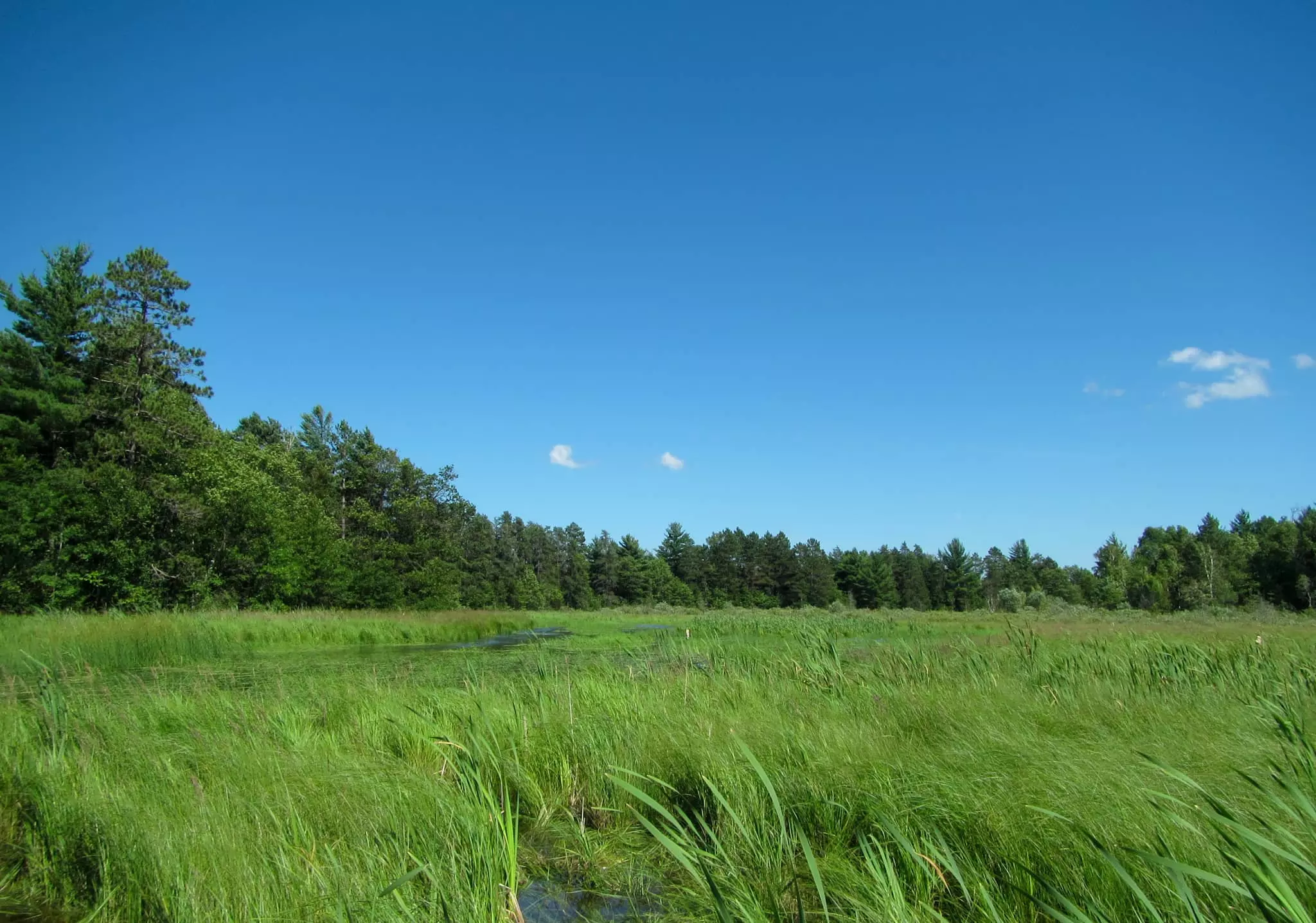Introduction
Healthy wetlands enhance our quality of life and provide many critical services and recreational opportunities. Wetlands are among the most productive ecosystems in the world, home to an immense variety of fish and wildlife. They filter out pollutants entering streams, lakes, and coastal waters. Acting as natural sponges, they capture and slowly release floodwaters. They buffer ocean shorelines from waves and storm surges. To learn more about EPA activities to protect and restore these vital resources, visit EPA’s wetlands page.
The National Wetland Condition Assessment (NWCA) is an EPA, state, and tribal partnership to assess the condition of wetlands across the United States (see acknowledgments for a list of partners). It is one of four statistical surveys in the National Aquatic Resource Surveys (NARS) program. For more information, see the NARS history page.
The National Wetland Condition Assessment: The Second Collaborative Survey of Wetlands in the United States presents the results of the 2016 survey of wetland conditions in the conterminous United States. The first survey took place in 2011.
During the spring and summer of 2016, 59 field crews sampled 1,056 wetland sites, using standardized sampling procedures to collect data on biological, chemical, physical, and human health indicators. The measured values were compared to NWCA benchmarks and EPA recommended water quality criteria to assess wetland conditions.
The NWCA is designed to answer the following questions about wetlands across the United States:
- What percent of wetlands support healthy ecosystems and recreation?
- What are the most common problems?
- Are conditions improving or getting worse?
- Are investments in wetland management and restoration focused appropriately?
The answers to these questions can help stakeholders plan for the protection and restoration of wetlands across the United States.
The NWCA design allows characterization of wetlands at national and regional scales using indicators of ecological condition and stress. It is not intended to represent the condition of individual wetlands. The statistical design also accounts for the distribution of wetlands across the country, even in areas where there are few wetlands.
This report focuses on NWCA results at the national scale, comparing the condition of wetlands in 2016 to that in 2011. EPA also analyzed results at the regional level, for both EPA regions and for five ecoregions. Noteworthy ecoregional results are highlighted for each indicator. Data included in the report were last updated April 18, 2022.
Results from the NWCA can help us better understand the condition of wetlands in the United States, some of the stressors affecting them, and how stressors relate to local conditions. While this report explores associations between biological indicators and stressors, it does not explain or identify the causes of degraded conditions or sources of stressors. Additional research is needed to address these questions. Further, data from future assessments will help determine whether changes observed between 2011 and 2016 represent a trend or result from natural variability.
KEY FINDINGS ON 2016 CONDITION
Key results for 2016 are summarized below. Following standard practices (described in the background section), EPA analysts classified results for most indicators as good, fair, or poor. The nonnative plant indicator had an additional condition category of very poor. For microcystins, a human health indicator, EPA classified wetlands based on whether they exceeded EPA’s recommended recreational water quality criterion for microcystins.
Many of the indicators included in the NWCA are natural components of wetland ecosystems but can also serve as measures of wetland degradation. For example, some level of a nutrient like phosphorus is necessary to support wetland communities, but excessive quantities can be detrimental. The NWCA explores how these measures compare to expectations or benchmarks.
Based on an analysis of plant communities, less than half of wetland area was rated good.
- Using vegetation multimetric indexes (MMIs) to evaluate wetland condition, EPA found 47% of wetland area was in good condition. (These indexes combine results from several metrics into one value.)
Nonnative plants are a concern.
- Using an indicator based on the occurrence and abundance of nonnative plants, EPA found the condition to be poor or very poor in 21% of wetland area.
Physical alterations to wetlands are widespread. The NWCA reports on six indicators of physical alteration, based on observations at each sampling site. These human-caused alterations directly affect vegetation, hydrology (water levels and the flow of water), or soil. The NWCA also measures the presence of multiple alterations at each site using a cumulative indicator that combines the results of the six indicators (shown below):
- Vegetation removal (e.g., logging, clearing, excessive browsing by livestock).
- Vegetation replacement (e.g., replacement with pasture or croplands).
- Flow obstruction (e.g., presence of dams or berms).
- Water addition or subtraction (e.g., ditches or culverts that direct water into or out of the wetland).
- Soil hardening (e.g., soil compaction, unpaved trails, and roads).
- Surface modification (e.g., sedimentation, erosion).
The results for the physical alteration indicators are described below:
- The combined indicator showed that 80% of wetlands were in fair or poor condition.
- Physical alteration indicators for soil hardening and water addition or subtraction were the most widespread of the six individual physical indicators; 54% and 50%, respectively, of wetland area was in fair or poor condition for these indicators.
- Most wetland area was rated good for surface modification (79%), flow obstruction (74%), vegetation replacement (69%), and vegetation removal (61%).
Chemical stressors of wetlands were not widespread, but when they were present at levels corresponding to poor conditions, the vegetation MMI score was twice as likely to also be poor.
- The NWCA reports on heavy metal concentrations in wetland soils, which can negatively impact ecological function and health. Soils were in good condition relative to the heavy metal indicator in 95% of wetland area.
- Nitrogen and phosphorus levels were measured at wetland sites where enough surface water was present to collect a water sample. Nitrogen and phosphorus conditions were found to be poor at 24% and 22% of wetland area, respectively. However, because many wetlands did not have surface water, 40% of wetland area could not be assessed for water chemistry.
- Poor condition for the vegetation MMI was twice as likely when chemical indicators for heavy metals in soils or total phosphorus in water also showed poor condition.
Algal toxins were present, but at very low levels, with minimal recreational human health concerns.
- Microcystins were detected in 8% but exceeded EPA’s recommended water quality criteria in less than 1% of wetland area. However, because many wetlands did not have surface water, 42% of wetland area could not be assessed for microcystins.
KEY FINDINGS ON CHANGE FROM 2011 TO 2016
EPA calculated changes in condition from 2011 to 2016, summarized below. Due to statistical adjustments, as well as changes to indicators and benchmarks for 2016, EPA recalculated 2011 condition for each indicator to allow valid comparisons to 2016 results. All comparisons between the first NWCA and this one should be made using the new information presented in this report and the dashboard.
For biological indicators (vegetation MMIs and nonnative plants), there was little change between surveys at the national level.
There were statistically significant changes in some physical alteration indicators.
- The vegetation replacement indicator showed a 10 percentage point increase in wetland area in good condition between 2011 and 2016.
- The water addition or subtraction indicator revealed that wetland area in good condition decreased 20 percentage points, with good condition dropping from two-thirds to less than half of wetland area.
- Soil hardening also became more widespread; area in good condition decreased by 13 percentage points, while area in fair condition increased by the same amount.
NWCA DASHBOARD
EPA developed an interactive dashboard to accompany this report. It contains regional results and allows comparisons between NWCA wetland groups. The NWCA dashboard also provides wetland acreage for condition categories.
Users can also access the dashboard by following the link at the bottom of each graph in this report. Those links will bring users to a customized page with regional data for each indicator. Users can then navigate to other dashboard views using the "Condition Estimates" dropdown and other dashboard controls.
HOW CAN I FIND OUT MORE?
Read the other sections of this report for more detail on the national results for each indicator. Explore the interactive dashboard to compare conditions in different types of wetlands. See the NWCA 2016 Technical Support Document (U.S. EPA 2023) for technical details on the survey design and data analyses that underpin the findings in this report. Additional information about the NWCA and the 2011 report is available at the NWCA home page. The NARS team prepares additional products using the science and data from the assessments. The NWCA homepage is updated as new items come out. Other NWCA information, such as published scientific research, is available at the main NARS website, along with NARS results for other surveys.
Background
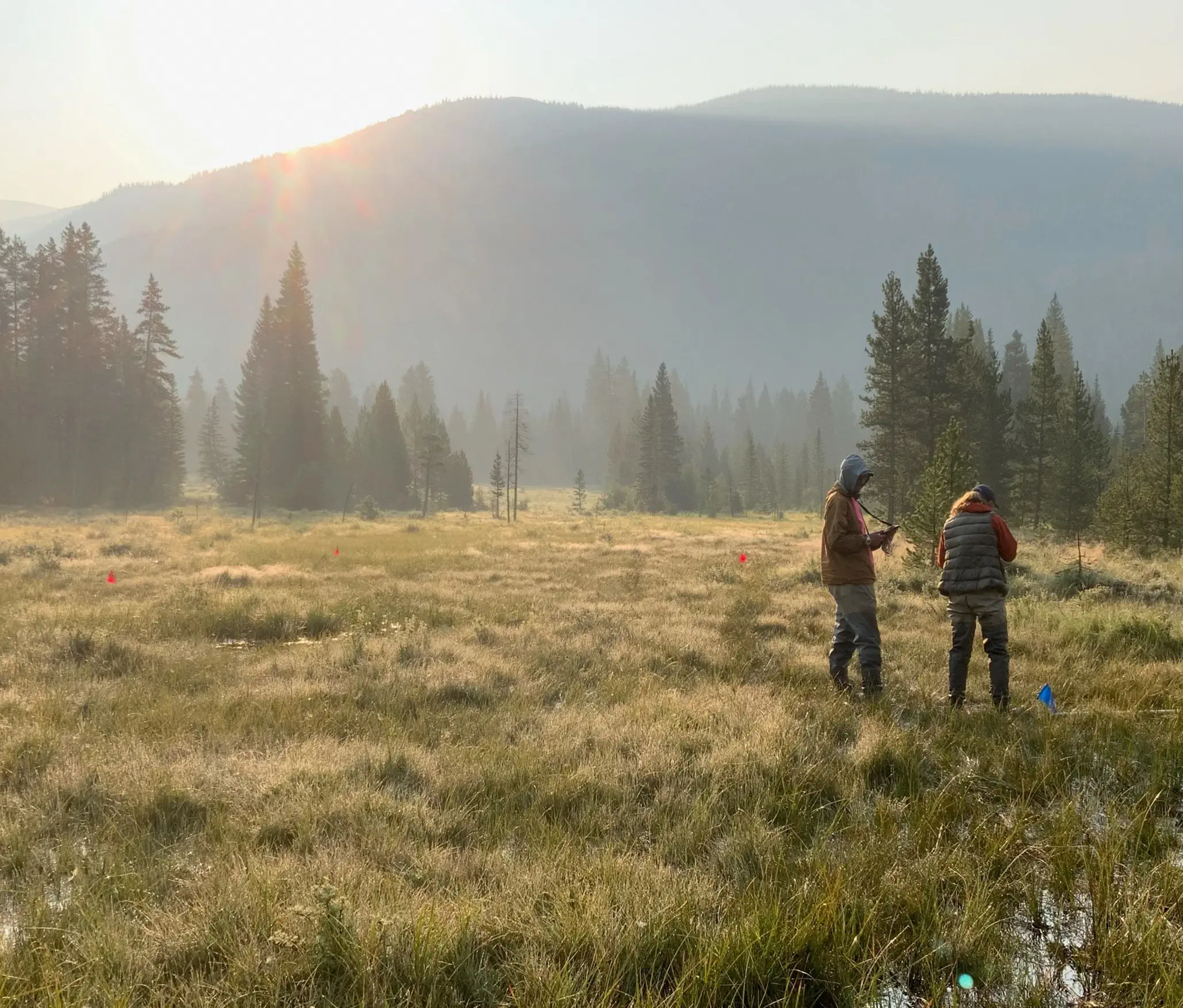
Field crew at Rocky Mountain National Park, Colorado. PG Environmental.
For 2016, EPA updated the survey design, some field protocols, how indicator scores were calculated, and the benchmarks used to assign disturbance classes and condition categories. EPA made every effort possible to balance the evolution of the survey while keeping the 2011 and 2016 data comparable.
This section provides a brief background on the survey methodology. For additional details on survey design, field methods, and quality assurance plans, see EPA’s NARS manuals page. For details on the NWCA 2016 survey design, see EPA’s design documents page.
ABOUT WETLANDS
Wetlands are areas where water covers the soil or is present either at or near the surface of the soil all year or for varying periods of time during the year. For the NWCA, EPA, states, tribes, and other partners surveyed many types of wetlands across the United States, including coastal salt marshes, mangrove swamps, inland marshes, seasonal wet prairie, bogs, and forested wetlands. See EPA’s wetland pages for a description of common wetland types.
CHOOSING INDICATORS
EPA used several indicators to assess the biological, physical, and chemical condition of wetlands. Indicators were chosen for their utility in reflecting ecological condition of wetlands or in indicating stress that may influence condition, as well as their applicability among wetland types and environments and the ability of crews to collect the needed data during a one-day site visit (see the Technical Support Document). EPA also used an indicator to assess characteristics that pose risks to human health. Although there are others that could be used to describe wetland condition, EPA has determined these indicators align with the goals of the survey described earlier and are the most representative at a national scale. EPA grouped indicators into four categories.
The survey included two biological indicators:
EPA measured seven physical indicators. Six individual indicators measured physical alterations to vegetation, hydrology, and soil, and one combined results from all six:
- Vegetation removal | Vegetation replacement | Flow obstruction | Water addition or subtraction | Soil hardening | Surface modification | Physical alterations (sum).
There were three chemical indicators:
Lastly, the survey tracked one human health indicator:
SELECTING WETLANDS
EPA used a statistical sampling approach to select 967 of the wetland sites visited for this assessment. This set of sites was used to estimate the condition of the broader population of wetlands across the United States and ensure that survey results were unbiased. For more information on statistical surveys, see What Are Probability Surveys? and Selecting a Sampling Design. The target population for the NWCA was the set of wetlands in the conterminous United States meeting the definition below. In addition to the 967 sites, EPA sampled 89 handpicked wetland sites that were anticipated to reflect low levels of disturbance. These sites were evaluated with the 967 from the statistical design to develop indicator metrics and benchmarks but were not used in the estimates of wetland conditions.
What Wetlands Were Included in This Survey?
The target population for the NWCA included all wetlands of the conterminous United States not currently in crop production. These included tidal and nontidal areas with rooted vegetation and, when present, shallow open water less than one meter deep.
The locations and boundaries of wetlands meeting the target population were obtained using National Wetland Inventory data maintained by the U.S. Fish and Wildlife Service. Information on how EPA consolidated and cross-walked the inventory data to the NWCA target population is in the Technical Support Document.
For the purposes of analysis and reporting, EPA categorized wetlands into four broad groups (see examples in Exhibit 1 below):
- Inland herbaceous (freshwater wetlands dominated by nonwoody species).
- Inland woody (freshwater wetlands dominated by shrubs or trees).
- Estuarine herbaceous (coastal wetlands in brackish or salt water, dominated by nonwoody species).
- Estuarine woody (coastal wetlands in brackish or salt water, dominated by shrubs or trees).
Four Wetland Groups Used to Classify Wetlands for NWCA 2016
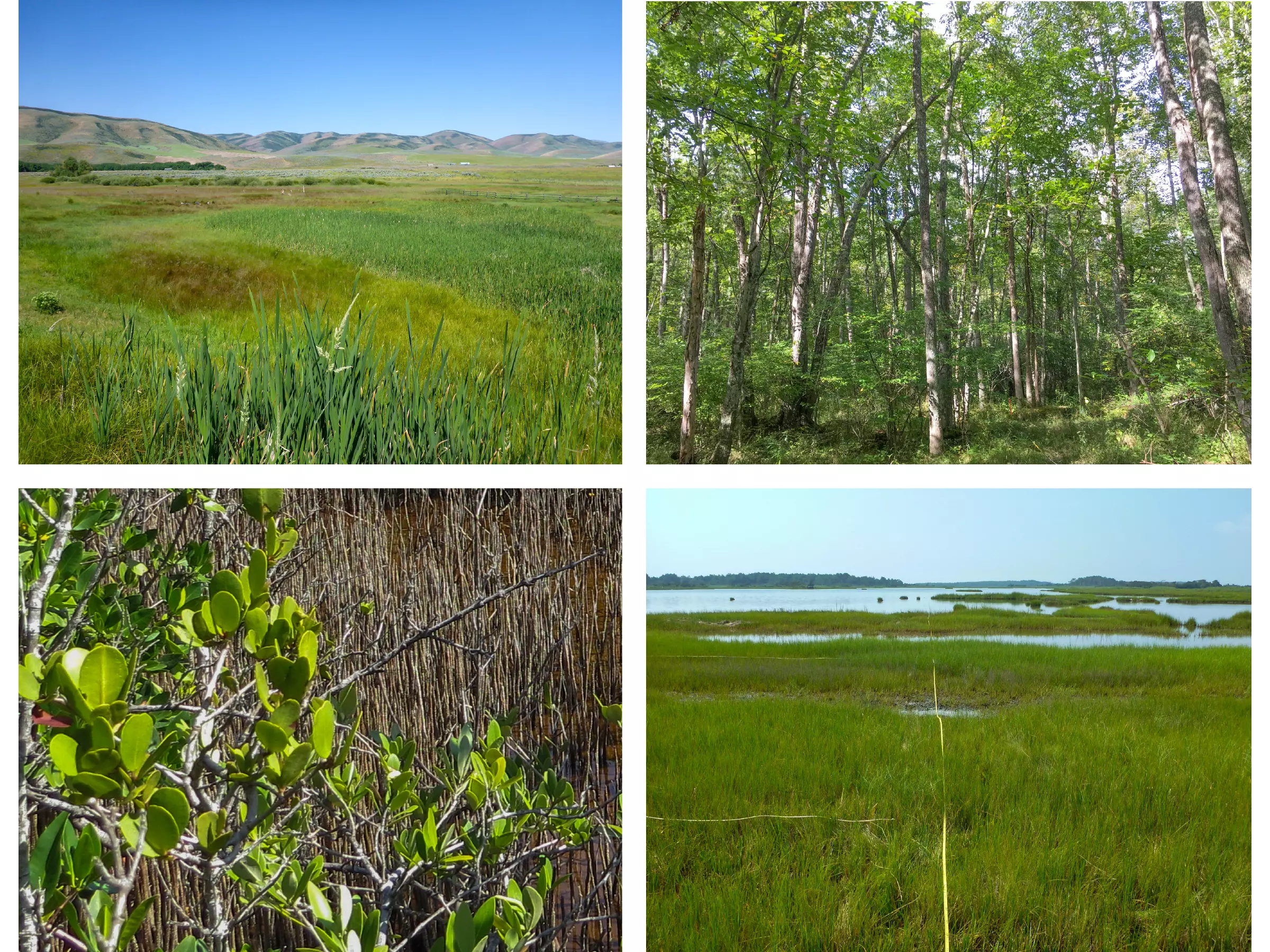
Clockwise, from the top left: an inland herbaceous site, Idaho (Idaho Department of Environmental Quality); an inland woody site, New Jersey (U.S. EPA); an estuarine herbaceous site, Maryland (Riparia Center at Pennsylvania State University); and an estuarine woody site, Florida (University of Florida).
The 967 wetland sites sampled were identified using a statistical method called stratified random sampling. This approach is used in environmental, social science, and health fields to determine the status of populations. In such a design, wetlands are categorized into groups (for instance, by type or location), and every wetland in the target population has a known probability of being selected for sampling.
The statistical design of the survey allows EPA to extrapolate the results from the 967 wetland sites sampled to approximately 95,694,241 acres of wetlands meeting the definition in the box above. Throughout this report, percentages reported for a given indicator apply to the 95,694,241 acres of wetlands in the target population. For example, if the condition is described as poor for 10% of wetlands nationally, this means that the area estimated to be degraded for that indicator is 9,569,424 wetland acres.
To produce the national results for each indicator, EPA used established statistical approaches to assign each of the 967 sites a weight based on the total wetland area that the site represents. This enabled EPA to estimate the proportion of wetland area in each condition category (e.g., good, fair, or poor). See the appendix and Technical Support Document for details.
When designing the survey, EPA considered the number of wetland sites that should be sampled. The greater the number of sites sampled, the more confidence in the results. The 967 sites sampled in the NWCA 2016 allow EPA to determine the extent of wetlands in each condition category for each indicator within a margin of error of approximately ±5%, with 95% confidence at the national scale. See Exhibit 2 for a map of the 2016 sampling sites and their distribution across five ecoregions.
Map of NWCA 2016 Sampling Sites in Each Ecoregion
FIELD SAMPLING
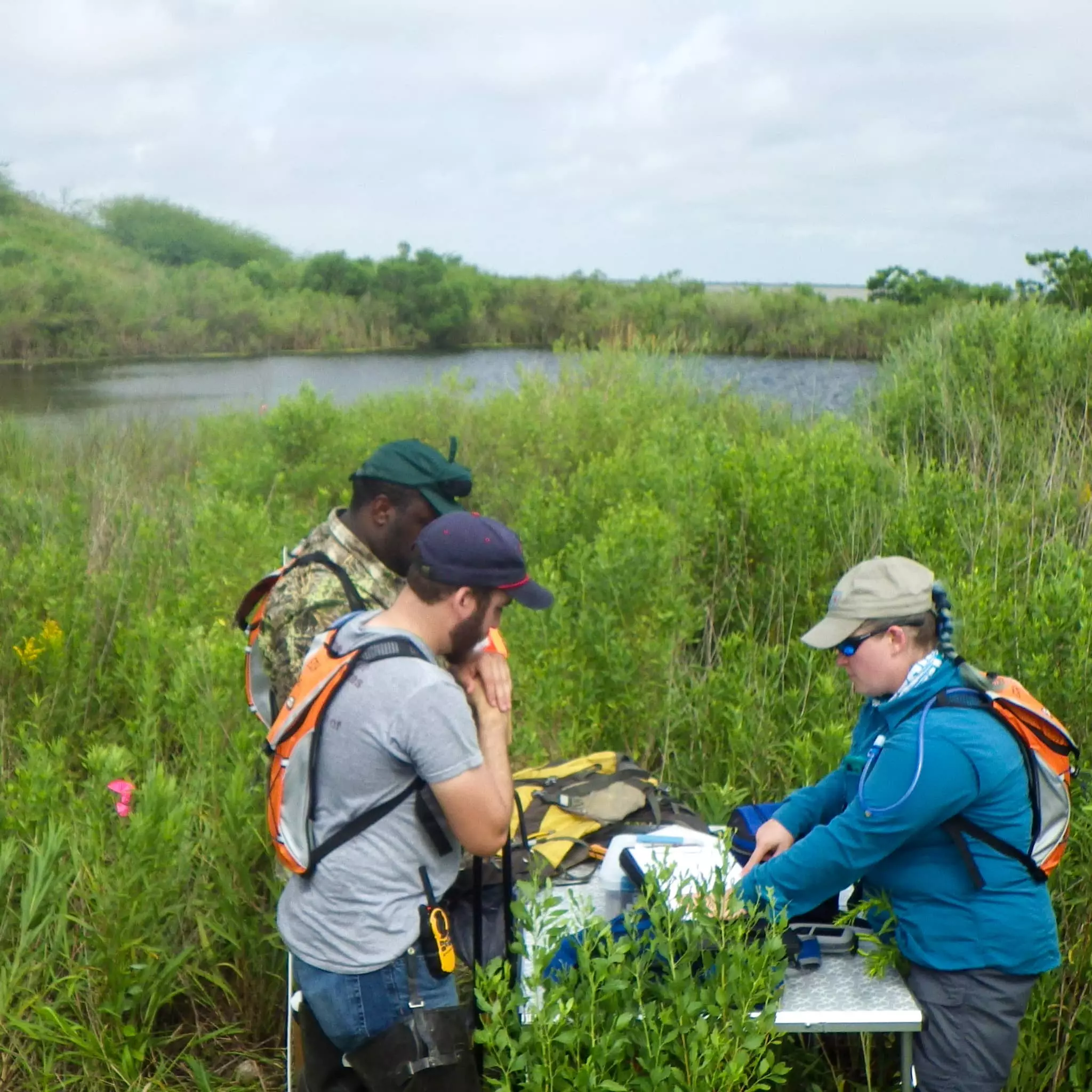
Field crew prepares for sampling. University of Houston-Clear Lake.
To ensure consistency in collection procedures and to assure the quality of resulting data, field crews participated in training, used standardized field methods, and followed strict quality control protocols (U.S. EPA 2016). Field and lab results were used to calculate scores for each indicator.
Field crews visited each wetland site once. They spent a full day collecting ecological data in a 0.5-hectare assessment area whose location was specified by the survey design documents. Crews collected additional data in a buffer area extending 100 meters from the assessment area edge (see Exhibit 3).
The crews collected data on vegetation, soils, hydrology, and water chemistry from the assessment area. Crews also collected data on the presence of human-caused physical alterations observed in the assessment area and buffer.
Field crews used the standard layout shown in Exhibit 3 at most sites. Occasionally this layout was not possible because of the size and shape of the wetland at the specified location or because upland or deep water was present. In such cases, the NWCA protocols allowed alternate assessment area layouts.
NWCA 2016 Standard Assessment Area Layout
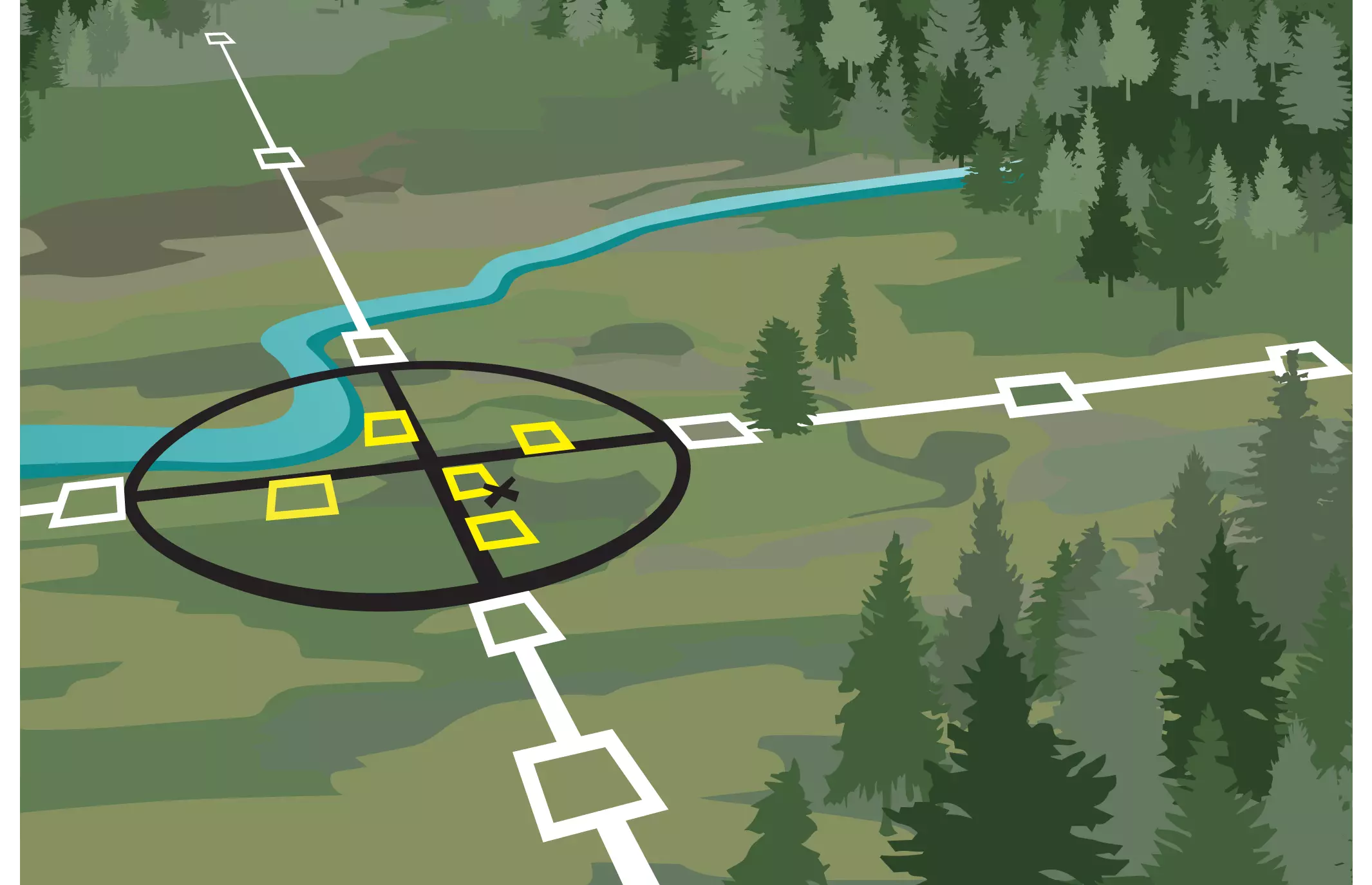
The black circle indicates the assessment area. Within that area, vegetation was documented inside five plots of 100 square meters each (yellow squares). Water sources feeding the wetland were noted and water quality samples taken where possible. At the southeast corner of the center-most vegetation plot (indicated by a black "X"), a soil pit was dug and soil chemistry samples were taken. In the buffer plots outside the assessment area (white squares), and in one plot at the center of the assessment area (not shown), crews checked for nonnative vegetation and signs of human disturbance.
ASSESSMENT BENCHMARKS
NWCA analysts reviewed the raw data for each indicator independently. Based on each site’s data, they assigned a condition category to the site for each indicator (for example, "above criterion" or "at or below criterion"; good, fair, or poor). Thus, a site could be in good condition based on data for one indicator and poor condition based on another. To assign the appropriate condition category, the NWCA 2016 used two types of assessment benchmarks.
The first type consisted of fixed benchmarks based on values in the peer-reviewed scientific literature, EPA published values, or professional judgment by the scientists analyzing the data. For example, EPA’s recommended water quality criterion was used nationally to classify wetlands as above the criterion or at or below the criterion for microcystins.
The second type consisted of NWCA-specific benchmarks based on the distribution of indicator values from a set of reference wetland sites. EPA set benchmarks nationally, regionally, or by wetland group, based on the indicators used or variations in indicator values. Such variations reflect differences in climate, geology, chemistry, ecology, and human disturbance. See the results chapter of this report for more on how benchmarks were applied.
The steps below describe EPA’s process for setting benchmarks and then determining wetland conditions, using a vegetation MMI as an example. Exhibits 4-7 provide an example of how the benchmark for the vegetation MMI for estuarine herbaceous wetlands was derived.
The process for setting condition benchmarks for the other vegetation MMIs and other indicators was similar. The Technical Support Document provides indicator-specific details (including details on screening for reference wetland sites).
1. Screen Wetlands to Identify Reference Sites. First, NWCA teams compiled wetland information from both NWCA surveys for both the statistically selected sites and a smaller set of handpicked sites thought to have low levels of human disturbance. EPA scientists evaluated these sites by considering reference screening factors such as physical alterations, soil heavy metals, and nonnative plant cover. Wetlands that passed screening were considered less disturbed than others and qualified as reference wetland sites. Exhibit 4 shows a map of estuarine herbaceous wetland reference sites. All were located in the Coastal Plains and Eastern Mountains/Upper Midwest ecoregions.
Estuarine Herbaceous Wetland Reference Sites
In Exhibit 5 below, each dot indicates the observed vegetation MMI score at one of the reference wetland sites. Possible index values range from zero to 100, with higher values indicating generally better wetland condition. Many of the dots overlap because they have similar values.
Vegetation MMI Values at Estuarine Herbaceous Reference Sites
2. Calculate Condition Benchmarks Using Reference Site Data. EPA then used the 5th and 25th percentiles of the distribution of vegetation MMI values observed at reference sites to set the benchmarks for the condition categories (see Exhibit 6 below).
Benchmarks for Condition, Based on Vegetation MMI at Estuarine Herbaceous Reference Sites
3. Assign Condition Categories to Wetlands. Using those vegetation MMI benchmarks, EPA assigned the condition (good/fair/poor) to each of the estuarine herbaceous wetlands that were randomly sampled as part of the NWCA. The exhibit below shows the vegetation MMI value for each estuarine herbaceous wetland site sampled in 2016 and the condition category in which it falls.
Vegetation MMI Values at Estuarine Herbaceous Sites Randomly Sampled During NWCA 2016
For NWCA 2016, EPA recalculated all benchmarks to include data from reference wetland sites sampled in 2016, strengthening confidence in the benchmark values. Robust benchmarks facilitate analyses of trends and changes in condition. Some indicators were also updated for 2016 (see the appendix and the Technical Support Document for description of revisions). Where indicators and their benchmarks were revised, data from the previous survey were reanalyzed using the new approaches and assessed against the new benchmarks to analyze change from 2011 to 2016.
The NWCA benchmarks are not equivalent to individual state water quality standards, and they do not replace the assessment by states and tribes of the quality of wetlands relative to their specific water quality standards under the Clean Water Act. For additional information on state-specific and local water quality data and assessments, visit EPA’s How’s My Waterway application.
National Results
This chapter presents information on each of the NWCA indicators. Each indicator section contains three parts: a brief explanation of why the indicator matters, results from the 2016 survey, and (when appropriate) change in condition from 2011 to 2016. All change results described in the text are statistically significant.
The graphs in this chapter show the estimated percentage of wetland area nationwide in each condition category (for example, good, fair, and poor). Each graph also shows the percentage of wetland area that was not assessed. Exhibit 8, below, explains the graphical conventions used throughout this report to provide a point estimate and 95% confidence interval for each set of results displayed.
How To Read the Graphs in This Report
This image is an example of a graph showing the estimated percentage of wetland area in each condition category in 2016. Similar conventions are used for graphs showing change between 2011 and 2016, and graphs (in the next chapter) showing attributable risk associated with stressors. In all graphs, values shown are rounded to the nearest whole number; however, calculations such as changes in condition are undertaken using more precise numbers. Consequently, readers may notice minor differences between values shown in the graphs and values provided in the text. Readers may also find that percentages across condition categories within a graph do not always total to 100%.
While this report focuses on national data, each graph in this chapter is accompanied by a customized link to the NWCA dashboard’s display of ecoregional data for the relevant indicator. For maps and characteristics of each ecoregion, visit the NARS ecoregions page.
Also, as mentioned earlier, the 2011 results reported here will differ from those reported in the NWCA 2011 report due to changes in indicators and benchmarks, as well as statistical adjustments to population estimates (see the appendix). All comparisons between the first and second NWCA should be made using the new information presented below and in the NWCA dashboard. The NWCA 2016 Technical Support Document (U.S. EPA 2023) further explains the underlying assumptions and analysis for the results in this chapter. To download the underlying data used to create this report’s estimates, visit the NARS data page.
BIOLOGICAL INDICATORS
Vegetation is a significant component of the biodiversity and structure of wetlands, and it provides habitat for microbes, insects, amphibians, reptiles, birds, and mammals. The composition and abundance of plant species reflect and influence wetlands hydrology, water chemistry, and soil properties. Vegetation is a particularly good indicator of wetland condition because of its ability to respond to physical, chemical, and biological disturbances at multiple temporal and spatial scales. For NWCA 2016, EPA used vegetation MMIs to indicate wetland conditions as a whole and used a nonnative plant indicator to evaluate the impact of nonnative species on wetlands.
Vegetation Multimetric Indexes
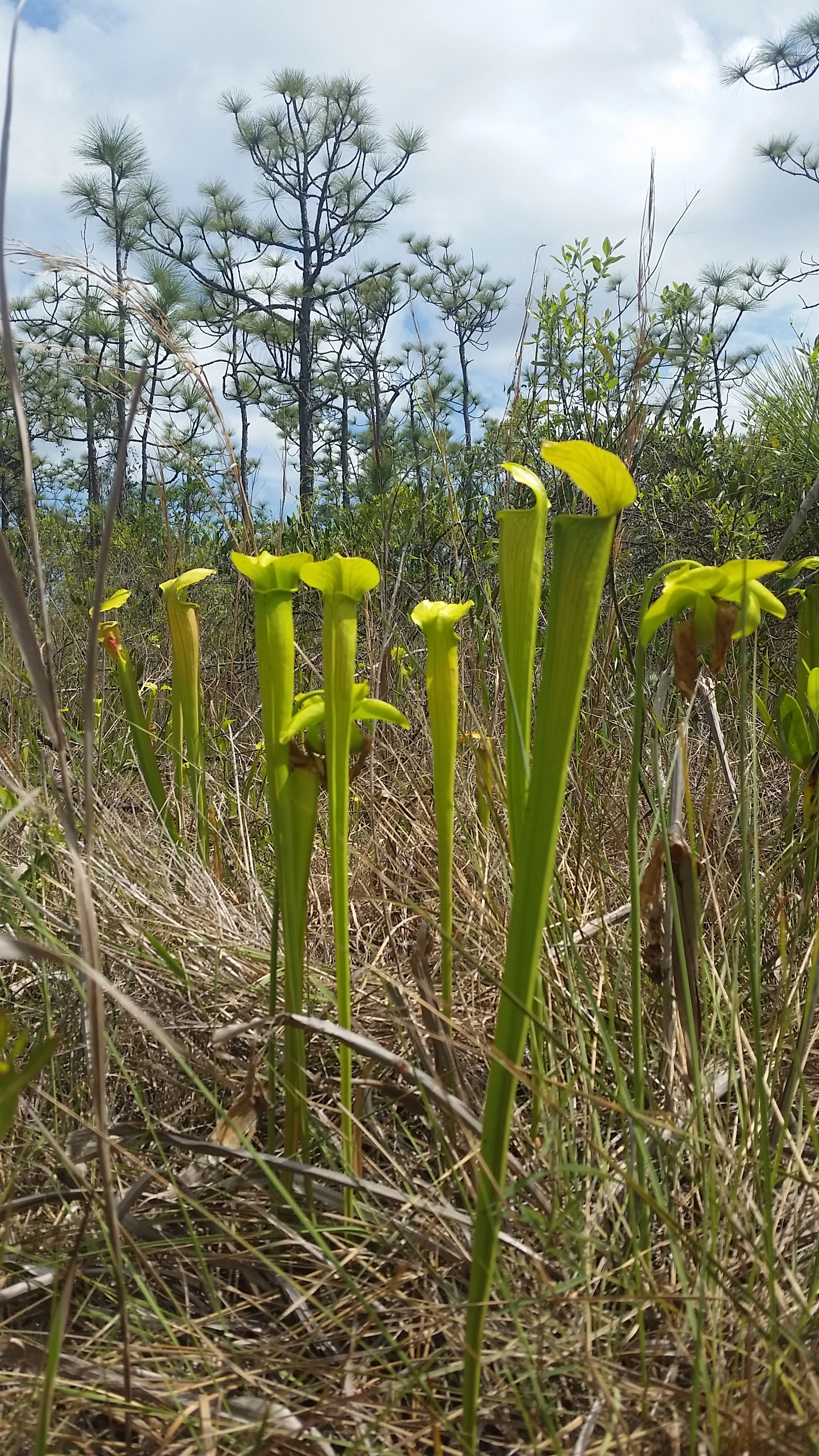
NWCA field crews measured area covered by native species such as these grasses and carnivorous pale pitcher plants (Sarracenia alata). PG Environmental.
The plant species at a site reflect climate and environmental conditions such as hydrology, soil properties, and water chemistry. For example, plants such as cattails have special adaptations for getting oxygen to their roots, allowing them to grow in flooded soils, and salt marsh grasses have adaptations that limit salt uptake. Human-caused disturbances that alter ecosystem properties can result in degraded wetlands. Plants may respond to this degradation with changes in the abundance of individual species or plant groups (e.g., shrubs, grasses, plants favoring wetter or dryer conditions) or with the disappearance or addition of species to a site. This responsiveness makes vegetation a particularly good indicator of wetland condition.
Because wetlands are complex and vary so much nationally and even locally, a good way to compare them is to create an index. Rather than comparing sites for the presence of specific species, scientists use indexes that can take into account the number and abundance of species, the kinds of species, and their sensitivity to disturbance. Such indexes can also be customized by wetland type and region.
An MMI combines multiple individual metrics into one index score to provide a holistic description of condition. For NWCA 2016, EPA developed four such vegetation MMIs, one for each NWCA wetland group (estuarine herbaceous, estuarine woody, inland herbaceous, and inland woody). Each index evaluates four to six vegetation characteristics.
The characteristics measured for each index varied but had common elements. Every index, for instance, included metrics describing species’ tolerance to human disturbance.
Botanists measure the ability of plants to tolerate disturbance by assigning a value from 0 to 10 for each species, where 10 is most sensitive to disturbance. This value may vary from state to state since species sensitivity can vary due to genetics, climate, and ecological interactions.
Every index documented native species using metrics such as the area covered by native species, the number of native species, or the percent of all species that were native. Several indexes also considered the prominence of certain graminoids (grasses and grass-like plants) or monocots (which include graminoids, orchids, lilies, irises, and others).
EPA calculated benchmarks for good, fair, and poor conditions for each index (see the assessment benchmarks section for a description of the benchmark development process). For three wetlands groups, benchmarks were set for the whole group, irrespective of location. For the inland woody wetlands group, EPA developed two sets of benchmarks, one for sites in the Xeric and Interior Plains ecoregions and one for sites in the Eastern Mountains/Upper Midwest, Western Mountains, and Coastal Plains ecoregions. See the Technical Support Document for details.
Almost one half of U.S. wetland area, 47%, was rated good based on the vegetation MMIs, as shown in Exhibit 9 below. The assessment also showed that 19% of wetland area was in fair condition, and 34% was in poor condition. Regionally, wetland conditions based on the vegetation MMIs varied, but the Interior Plains and Xeric ecoregions had the greatest percentages of area in poor condition, with 72% and 86%, respectively.
No statistically significant changes occurred nationally. A small but statistically significant decrease in area in fair condition was observed for the Interior Plains subpopulation, however.
Nonnative Plant Indicator
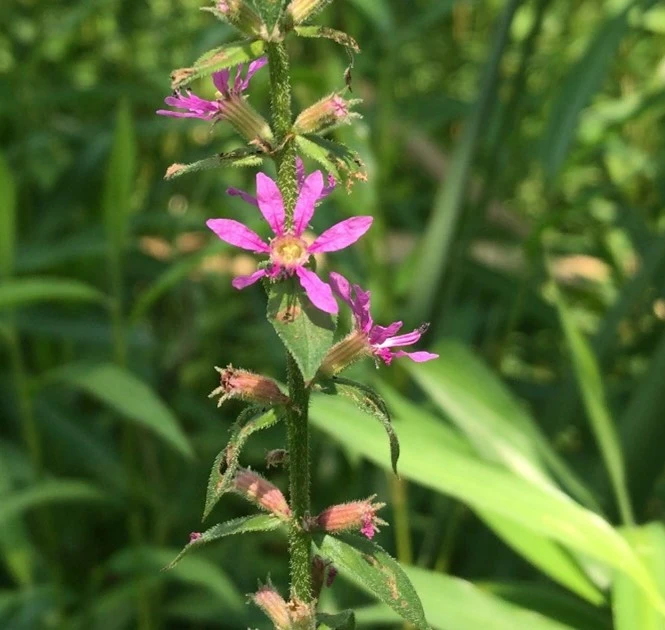
Purple loosestrife (Lythrum salicaria) is an herbaceous plant, originally from Europe and Asia, that is found in most states but has become particularly invasive in northeastern wetlands. Macy Carr, Oak Ridge Associated Universities.
Nonnative plants can directly and indirectly affect native vegetation and ecosystem components. Some nonnative plant species become invasive outside their regions of origin because they outcompete native species or change ecosystem properties. Even species native to one part of the United States can become invasive elsewhere. Saltmarsh cordgrass, for instance, is native to the East Coast but is invasive on the West Coast. Nonnative species that are not currently considered invasive may become so over time, and the presence of nonnative species indicates disturbed conditions and change from the expected plant community.
When native plants are squeezed out by nonnative plants, insects, amphibians, birds, and mammals that rely on native plants also face pressure, because nonnative vegetation often provides inferior habitat and food. In addition, changes driven by nonnative plants to vegetation structure or to the kinds of plants present can alter ecosystem services like flood reduction, carbon storage, and water-quality enhancement.
The nonnative plant indicator includes three complementary metrics readily calculated from field observations. These metrics consider the percentage of area covered by nonnative species, the number of unique nonnative species, and the number of plots containing nonnatives (the frequency of nonnative species occurrence).
Wetlands were assessed as having good, fair, poor, or very poor condition for this indicator based on whether the calculated value for each metric exceeded benchmark values established using best professional judgment. See the Technical Support Document for details.
Condition based on the nonnative plant indicator was good in 57%, fair in 22%, poor in 9%, and very poor in 12% of wetland area across the United States. Regionally, good condition ranged from 11% in the Interior Plains ecoregion to 74% in the Coastal Plains ecoregion.
No statistically significant changes occurred at the national level. Significant changes in poor or very poor condition did occur in three ecoregions. The largest of these was a decrease in poor condition of 11 percentage points in the Interior Plains.
PHYSICAL INDICATORS
Modifying physical features of wetlands or the surrounding area may directly or indirectly impair wetland function and diminish ecological conditions. Observations of these physical alterations can indicate the degree of disturbance to a wetland and, ultimately, its condition.
Field crews used checklists to document physical alterations. Hydrology-related alterations were observed across the assessment area and in 12 plots (100 square meters each) in the buffer area surrounding the assessment area. Vegetation and soil-related alterations were observed in the 12 buffer plots, as well as an additional plot at the center of the assessment area. For each observed alteration, EPA assigned points based on distance from the assessment area. A score of zero meant no alterations were observed, indicating good condition. A score above 50 indicated poor condition.
Some physical alterations can occur naturally. For instance, beavers build dams that impede the flow of water into and out of wetlands, and native animals browse vegetation. In calculating physical alteration scores, EPA attempted to exclude naturally occurring alterations.
The NWCA physical indicators of stress included the presence of two types of vegetation alteration (removal or replacement), two types of hydrologic alterations (flow obstruction or water addition/subtraction), and two types of alterations affecting soil (surface modification or soil hardening). EPA also developed a summary indicator, which combined scores for the other six indicators.
Vegetation Removal
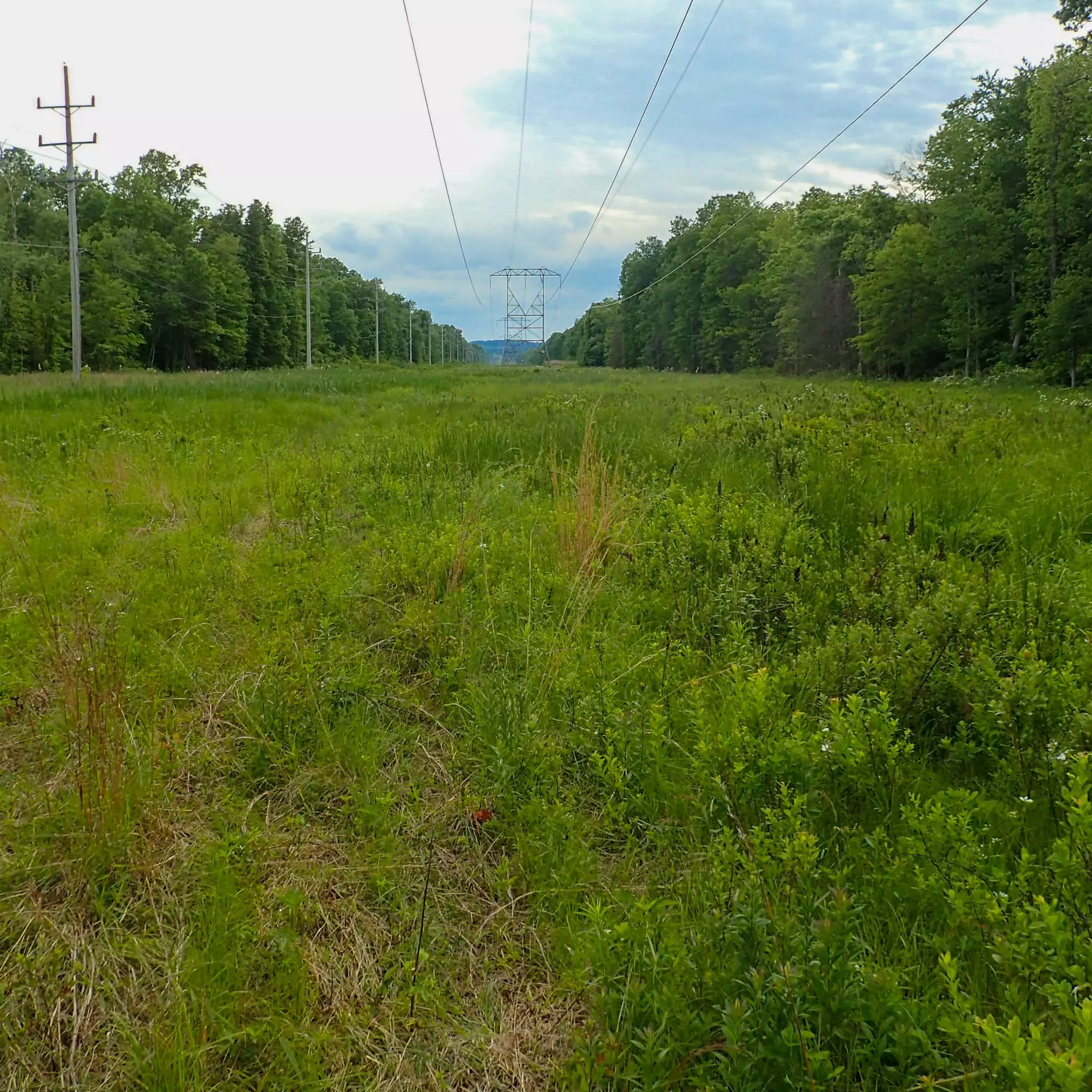
The vegetation under this transmission line is continually mowed and pruned to keep the area clear. New Jersey Department of Environmental Protection.
The vegetation removal indicator evaluates the loss, removal, or damage of vegetation due to human activity. Examples of removal activities include logging, mowing, excessive grazing by livestock or feral animals (such as hogs or nutria), herbicide use, and fire. Removal of vegetation may increase sediment, nutrient, and pollutant loads entering or collecting in a wetland.
Nationally, the vegetation removal stressor rating was good for 61%, fair for 34%, and poor for 3% of wetland area. Another 2% of wetland area was not assessed due to missing data.
There were no statistically significant changes nationally. Results from the Coastal Plains ecoregion indicated an increase in good condition of 18 percentage points. In comparison, the Eastern Mountains/Upper Midwest and the Xeric ecoregions both showed decreases in good condition of 19 and 17 points, respectively. These results were statistically significant.
Vegetation Replacement
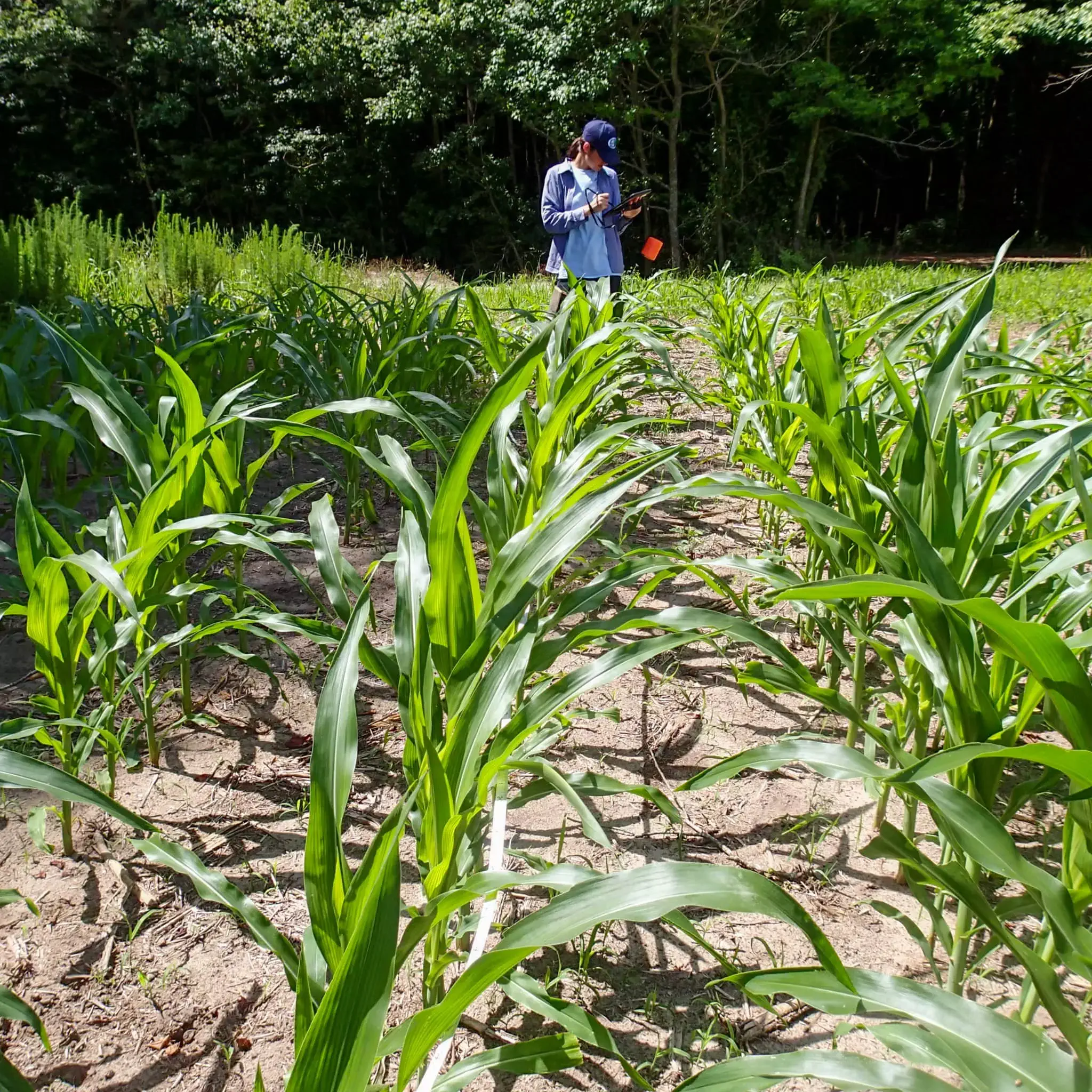
Row crops have replaced the native vegetation outside of this forested wetland. Delaware Department of Natural Resources and Environmental Control.
The vegetation replacement indicator reflects conversion of natural vegetation structure and composition due to human activity. Alterations could include conversion of natural plant communities to pasture, row crops, golf courses, lawns, parkland, or nursery. Native plant species in rangeland could also be replaced by nonnatives, leading to changes in plant communities and native species richness, even if land use remains unchanged. Vegetation replacement can decrease biodiversity, simplify the vertical structure, and reduce habitat quality on the site.
Nationally, the vegetation replacement stressor rating was good for 69%, fair for 20%, and poor for 8% of wetland area. Another 2% of wetland area was not assessed due to missing data. The Xeric ecoregion had the largest proportion of wetland area rated poor, at 39%.
The percentage of wetland area rated good for the vegetation replacement indicator increased 10 percentage points, from 59% to 69%. The percentage of wetland area in fair condition declined from approximately 33% to 20%. These changes were statistically significant.
Flow Obstruction
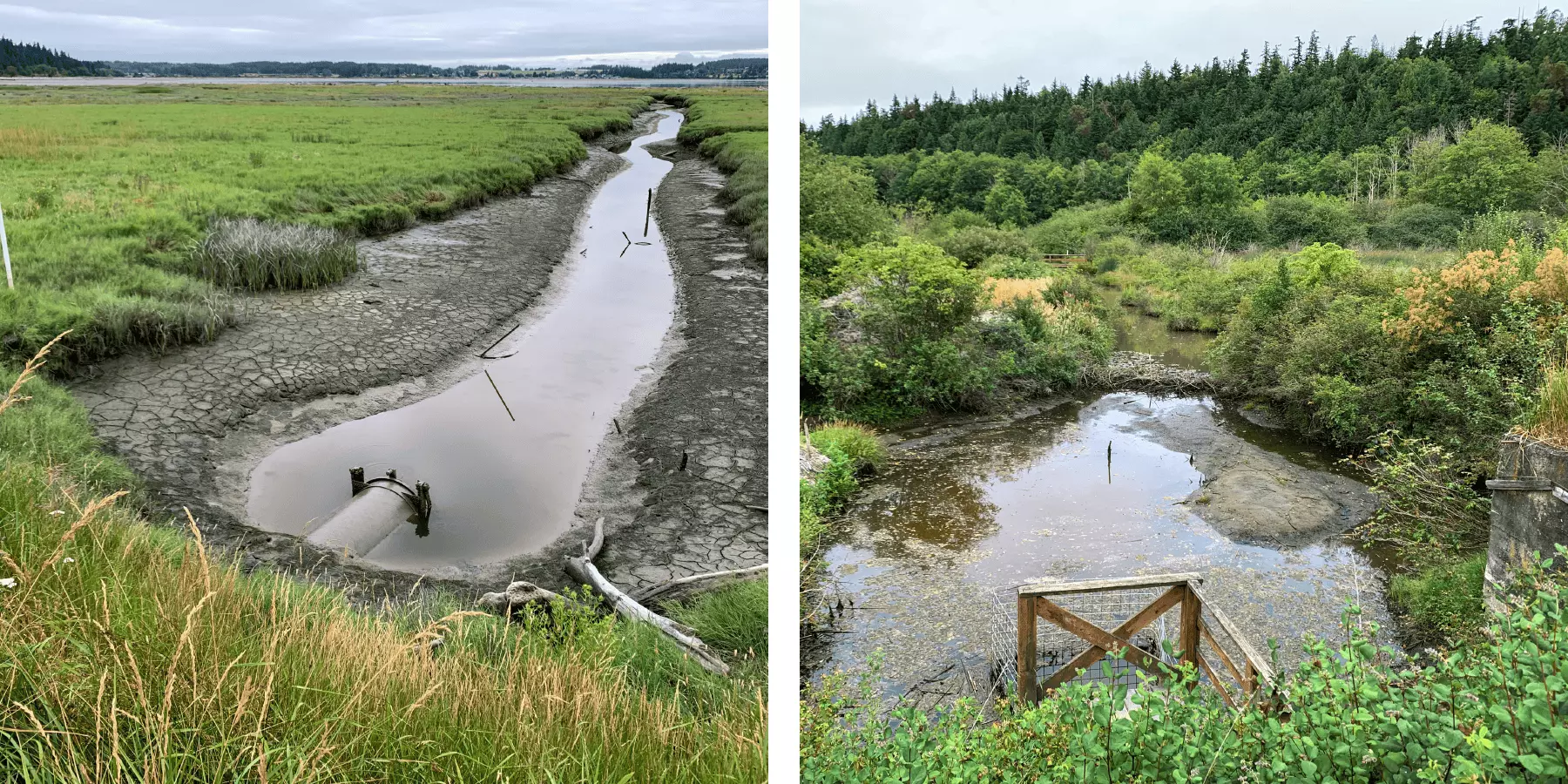
Photos show each side of a tide-gated culvert through a dike that separates an NWCA site from the waters of Puget Sound (left, in the distance). The gate restricts the tidal flow of saltwater, changing the marsh vegetation (right). Tynan Ramm-Granberg, Washington State Natural Heritage Program.
The flow obstruction indicator reflects human activities that can impound or impede water flow into, out of, or within the wetland (e.g., dikes, dams, berms, railroad beds). Changes in water flow resulting from hydrologic alterations can affect vegetation, nutrients, and habitat, thereby impacting the overall ecological condition of the wetland. For example, roadbed construction near coastal wetlands can cut off or reduce tidal flow, changing a marsh from saltwater to freshwater, and eliminating daily fluctuation in water levels needed to support certain types of marsh vegetation.
Stress from flow obstructions was low overall. Condition was rated good in 74%, fair in 21%, and poor in 3% of wetland area in the United States. The remaining 2% of wetland area was not assessed.
No statistically significant changes occurred at the national level. There was a statistically significant increase of 21 percentage points in wetland area rated good in the Western Mountains ecoregion.
Water Addition or Subtraction
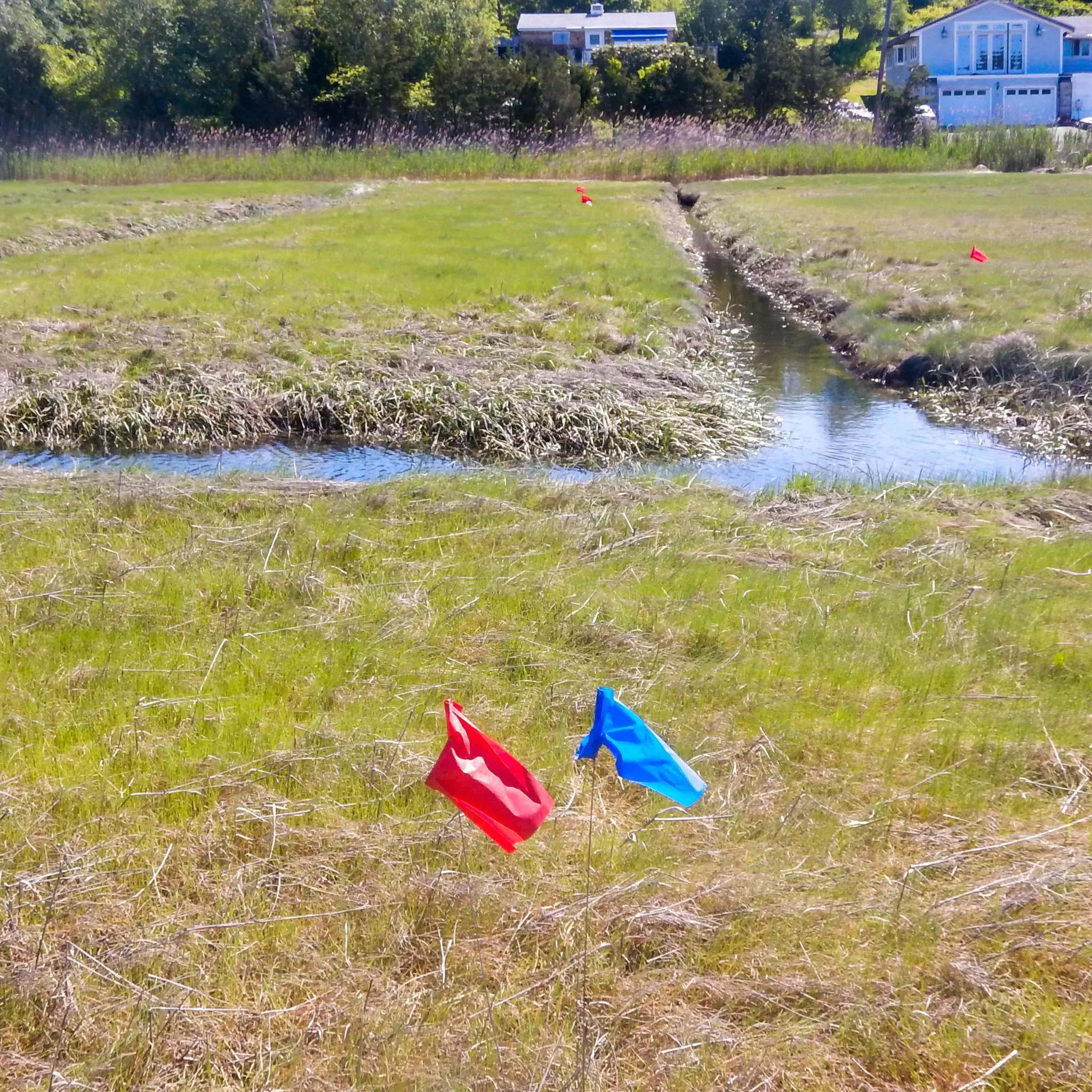
Ditches affect how water moves in and out of wetlands. PG Environmental.
The water addition or subtraction indicator reflects modifications that drain or add water to the site (e.g., ditches, culverts, stormwater outfalls). Some modifications, such as vehicle ruts that become stream channels, may be unintentional but are impactful, nevertheless. Changes in how water moves into or out of a wetland can affect plant productivity, nutrient cycling in the soil and water, and the physical habitat, thereby impacting the overall ecological condition of the wetland. For example, ditches allow water to drain from the soil quickly and can lower the water table enough to dry out the soil surface.
The water addition or subtraction indicator showed good condition in 48%, fair in 42%, and poor in 8% of wetland area across the United States. The remaining 2% of wetland area was not assessed.
The percentage of wetland area in good condition based on the water addition or subtraction indicator decreased by nearly 20 percentage points. The percentage of wetland area in fair condition increased 14 percentage points, from 28% to 42%. Of the five aggregated ecoregions assessed, results for three indicated declines in good condition (the Coastal Plain, Eastern Mountains/Upper Midwest, and Western Mountains), while one (Xeric) showed improvements in the proportion of good condition. These changes were all statistically significant.
Soil Hardening

Impervious surfaces such as the roads, sidewalks, and buildings in this residential area just outside an NWCA site directly impact habitat, plant, and soil integrity in wetlands. Moss Landing Marine Laboratories.
The soil hardening indicator reflects activities and infrastructure that result in compaction of soil and the addition of impervious surfaces (e.g., parking lots, roads, buildings, unpaved trails). Agriculture and vehicle use are examples of activities that can cause compaction. Soil compaction and impervious surfaces can directly impact wetland habitat, plants, and soil integrity by hindering root growth and diminishing a wetland’s natural ability to filter and retain floodwaters.
The soil hardening indicator showed good condition in 44%, fair in 47%, and poor in 7% of wetland area across the United States. The remaining 2% of wetland area was not assessed. The Xeric and Western Mountain ecoregions had the largest proportion of wetland area in poor condition, with 24% and 22%, respectively.
The percentage of wetland area in good condition decreased from 58% to 44% from 2011 to 2016. The percentage of wetland area in fair condition increased by 13 percentage points, from 34% to 47%. These changes were statistically significant.
Surface Modification
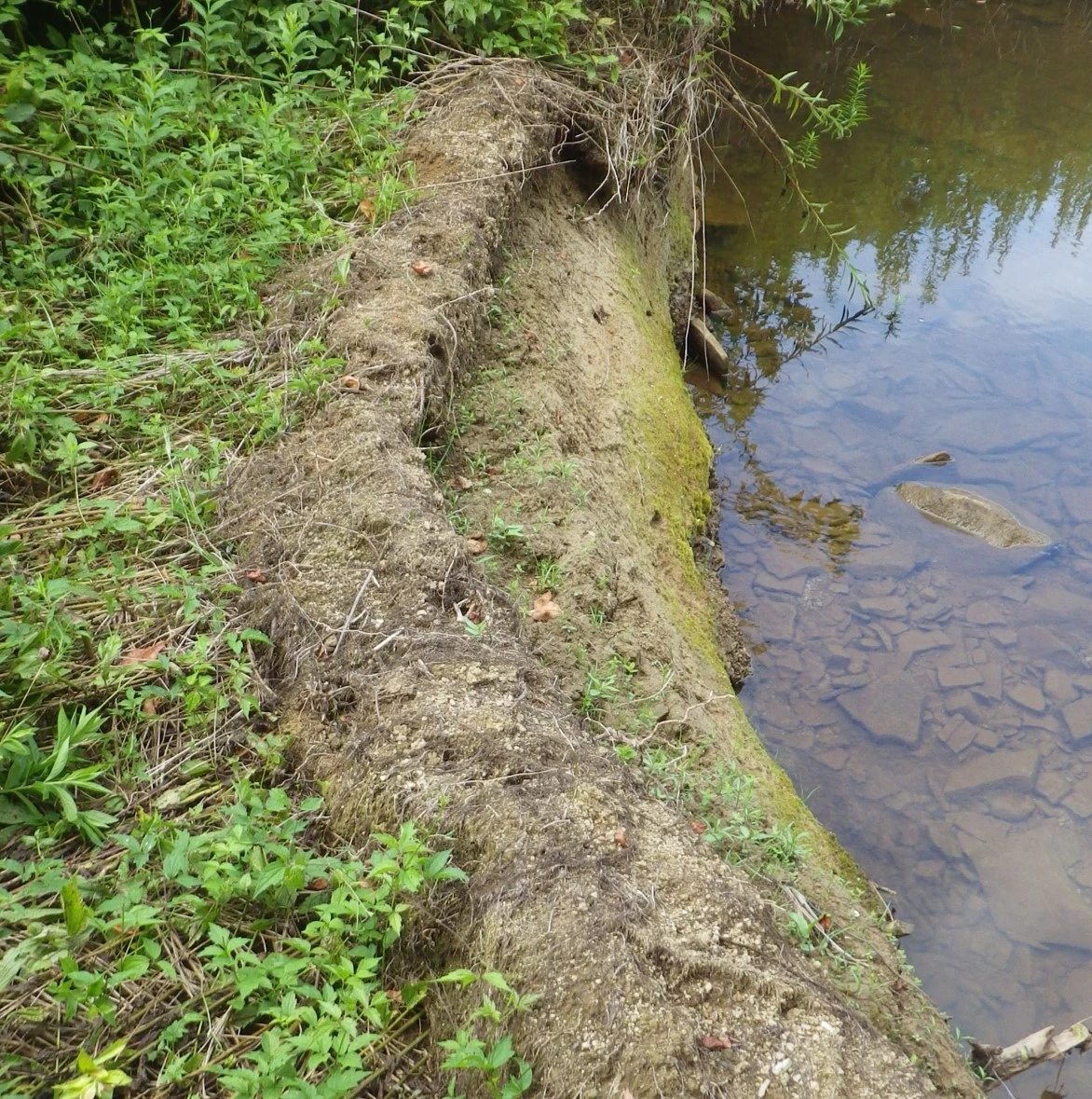
Evidence of erosion and deposition at the edge of a wetland stream. West Virginia Department of Environmental Protection.
The surface modification indicator reflects evidence of soil erosion or deposition. Examples include the following:
- Soil loss or exposure of plant roots.
- Excavation or dredging (removal of soil or sediment).
- Deposition of fill or spoil from elsewhere.
- Freshly deposited sediment carried by runoff.
Soil erosion within a wetland can result in wetland loss, while erosion outside a wetland may indicate that excess sediment is being deposited in the wetland. Filling can raise the wetland surface far enough above the water table that it is no longer a wetland. The soil or sediment deposited may also have a different physical and chemical composition than the native wetland soil, affecting the health and growth of native species.
The surface modification indicator showed good condition in 79%, fair in 18%, and poor in 1% of wetland area across the United States. The remaining 2% of wetland area was not assessed.
No statistically significant changes occurred at the national level. In the Coastal Plains, however, the percentage of wetland area in good condition increased 11 percentage points, a statistically significant change.
Physical Alterations (Sum)
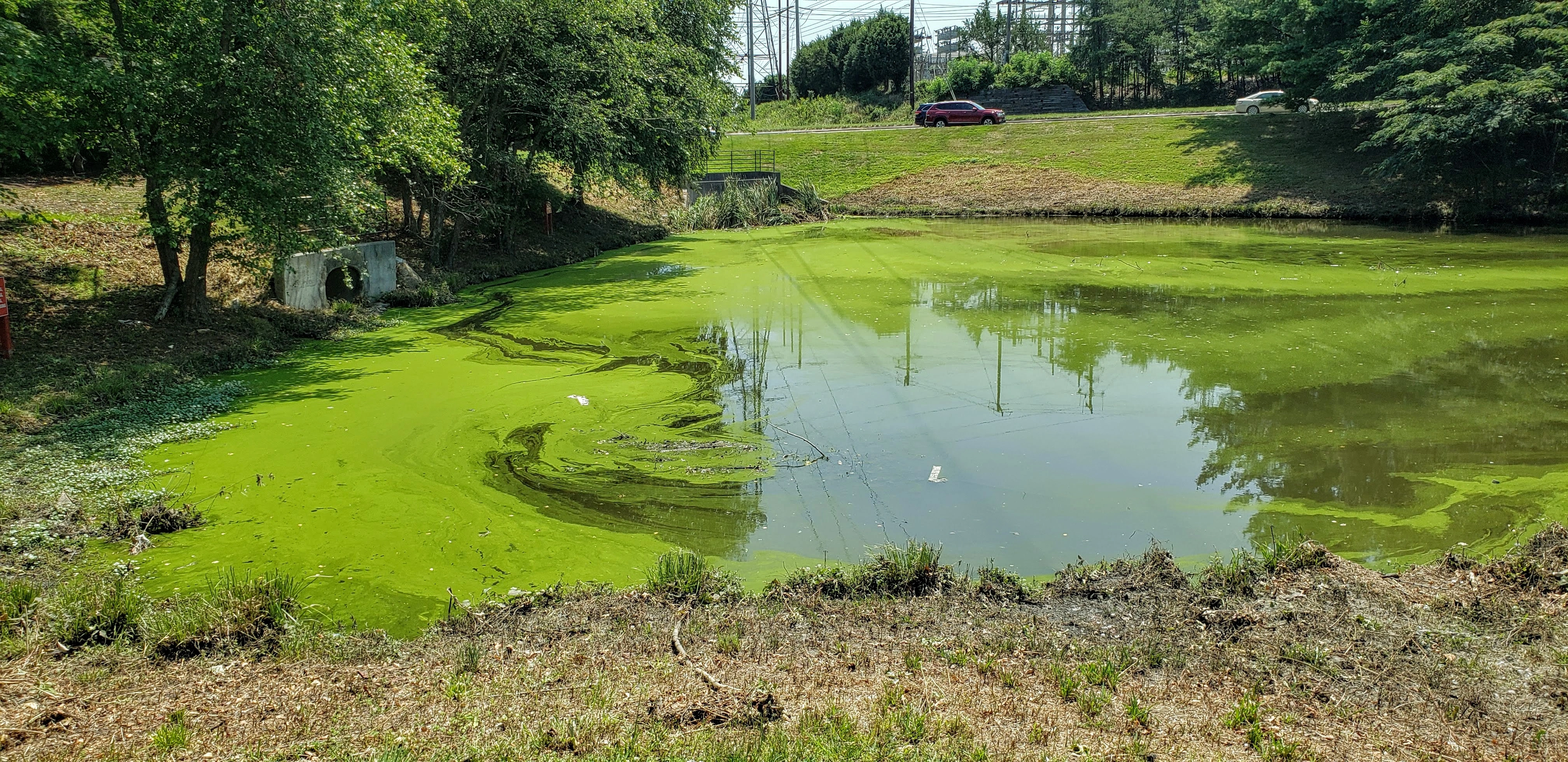
Multiple physical alterations in and around this wetland include road construction, culvert and weir installation, mowing and spraying of buffer vegetation, and replacement of natural vegetation with lawn. Natalie Auer.
In addition to looking at the six physical alterations separately, analysts also examined the combined impact of degradation described by the six indicators by adding up the numeric scores for each indicator. This enabled EPA to determine the extent to which wetlands were subject to multiple types of alterations and to estimate the combined effect on wetland conditions. The benchmarks remained the same as for individual physical alteration indicators, with zero (no observed alterations) indicating good condition, and a score above 50 indicating poor condition.
The combined physical alteration indicator showed good condition (low levels of physical stressors) in 18%, fair in 44%, and poor in 36% of wetland area across the United States. The remaining 2% of wetland area was unassessed. Each of the physical alteration indicators included in the combined indicator showed good condition in 40% or more of wetland area. The finding that only 18% of area was in good condition for the combined indicator illustrates that many sites are subject to multiple physical alterations.
The Coastal Plains had the largest area in good condition, at 28%.
No statistically significant changes occurred at the national level. Regionally, in the Eastern Mountains/Upper Midwest, the area in good condition decreased 19 percentage points. In the Xeric ecoregion, condition improved; area in poor condition decreased 24 points, from 89% to 65%.
CHEMICAL INDICATORS
Chemical stressors affecting wetland conditions include excess nutrients, metals, organic toxins, and others. These stressors can disrupt nutrient cycles, affect plant and animal growth, and be detrimental to human health. Three chemical indicators of stress were developed for NWCA 2016 using data from samples collected at each site: a soil heavy metal indicator and two water chemistry parameters (total nitrogen and total phosphorus). At some sites, collecting a soil sample was impossible because of ponded water or other site conditions on the sampling day. Water samples were only collected at sites where surface water was available.
Soil Heavy Metals
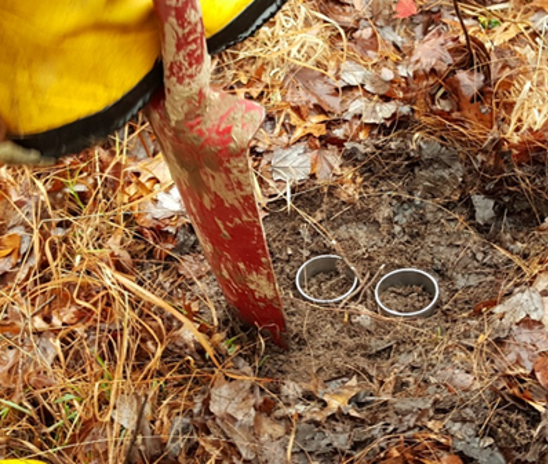
Sampling for soil chemistry. High metal concentrations in soil can affect vegetation growth. U.S. EPA.
The soil heavy metals indicator assessed concentrations of 12 different heavy metals and how these concentrations compared to background levels. The metals, all closely associated with human activities, were antimony, cadmium, chromium, cobalt, copper, lead, nickel, silver, tin, tungsten, vanadium, and zinc. The benchmarks established for this indicator do not reflect toxicity; rather, they are indicators of human disturbance. That is, concentrations above these benchmarks are not very likely to occur naturally. Sites were assigned a rating of good condition if no more than one of the 12 metals exceeded the benchmarks and no single heavy metal concentration was more than five times the background level. If three or more metals were above the benchmark or any single heavy metal concentration was more than 10 times the background level, a site was rated poor.
Wetland heavy metal soil contamination can be due to runoff from roads, industrial discharges to air or water, mining operations, agriculture, or illegal dumping.
Measured concentrations of heavy metals were below background levels across most wetland area. The assessment indicated good condition in 95%, fair in 3%, and poor in 2% of wetland area across the United States. The Western Mountains had the highest proportion of area in poor condition at 8%. Due to improvements in sample collection protocols, the wetland area assessed in 2016 changed compared to 2011. Comparison between 2011 and 2016 is not presented for soil heavy metals because it is not possible to determine whether changes are related to the increase in area assessed or an actual change in condition for the indicator.
Water Chemistry
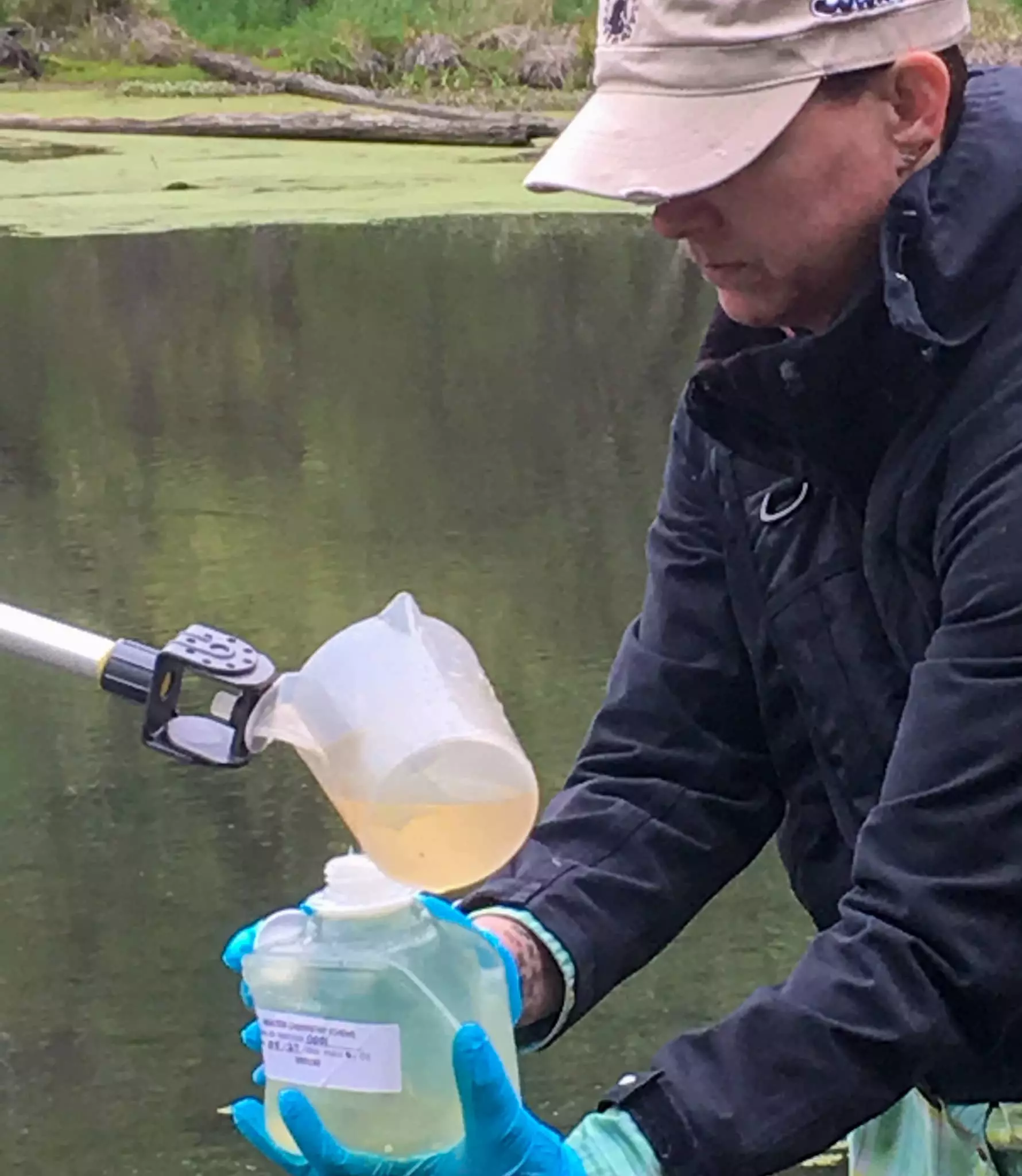
Collection of a water sample. U.S. EPA.
Characterizing water chemistry is an integral part of aquatic resources assessment, because water’s physical and chemical properties directly reflect the surrounding environment, including human influences. However, wetlands differ from lakes, streams, and coastal waters because surface water is not necessarily present. Furthermore, some wetland types, such as tidal wetlands and riverine wetlands, are more likely to have surface water at the time of sampling than other types, such as slopes and flats. Thus, the population of wetlands with surface water is not a random subset of the total wetland population surveyed in the NWCA (i.e., the population of wetlands with surface water is biased towards wetlands that are characterized by continuous surface water). At sites with surface water, water samples were collected and analyzed for a number of water quality parameters. This section describes results for two indicators, total nitrogen and total phosphorus, measured in the water column.
Some wetlands, such as marshes, have naturally high levels of nitrogen and phosphorus in their water due to contributions from surface water sources or decaying vegetation. Fens and bogs, on the other hand, have quite low levels since they get their water from direct rainfall and groundwater, which are naturally low in nutrients. Urban stormwater runoff, agricultural runoff, and septic systems are common sources of nutrients. Even wetlands with naturally high nutrient levels can be damaged by nutrient pollution, which can cause excessive plant and algae growth and may lead to changes in the abundance or occurrence of plant species at a site.
Since total nitrogen and total phosphorus are highly variable in wetlands, there are no national or regional literature-based benchmarks for these indicators. Thus, EPA developed benchmarks for good, fair, and poor conditions using an approach similar to the one described in the assessment benchmarks section. Separate benchmarks were developed for inland and estuarine wetland subpopulations. See the Technical Support Document for specific details.
Due to improvements in sample collection protocols, the wetland area assessed in 2016 changed compared to 2011. Comparison between 2011 and 2016 is not presented for nutrients because it is not possible to determine whether changes are related to the increase in area assessed or an actual change in condition for the indicators.
In 2016, 25% of wetland area was in good condition, 13% was in fair condition, and almost 22% was rated poor for total phosphorus in water. Note that 40% of wetland area was not assessed due to insufficient surface water for sample collection. Regionally, the Interior Plains had the smallest percentage in good condition, 7%, and the largest percentage in poor, 43%.
For more details, download the data for this chart, or visit the NLA dashboards for ecoregional data on water quality phosphorus.
In 2016, 20% of wetland area was in good condition, 16% was in fair condition, and 24% was rated poor for total nitrogen in water. Note that 40% of wetland area was not assessed due to insufficient surface water. As with phosphorus, the Interior Plains had the smallest percentage of area in good condition and the largest in poor.
For more details, download the data for this chart, or visit the NLA dashboards for ecoregional data on water quality nitrogen.
HUMAN HEALTH INDICATOR
The NWCA examined one human health indicator, focusing on exposure to algal toxins called microcystins. Exposure might occur while boating or through other contact with wetland waters. Because people do not generally swim in wetlands, and many wetlands do not have fish large enough for human consumption, recreational exposure to human health risks is expected to be less in wetlands than in other waters. As a result, NWCA does not analyze water for bacterial concentrations or fish tissue contamination as other surveys in the NARS program do.
Microcystins
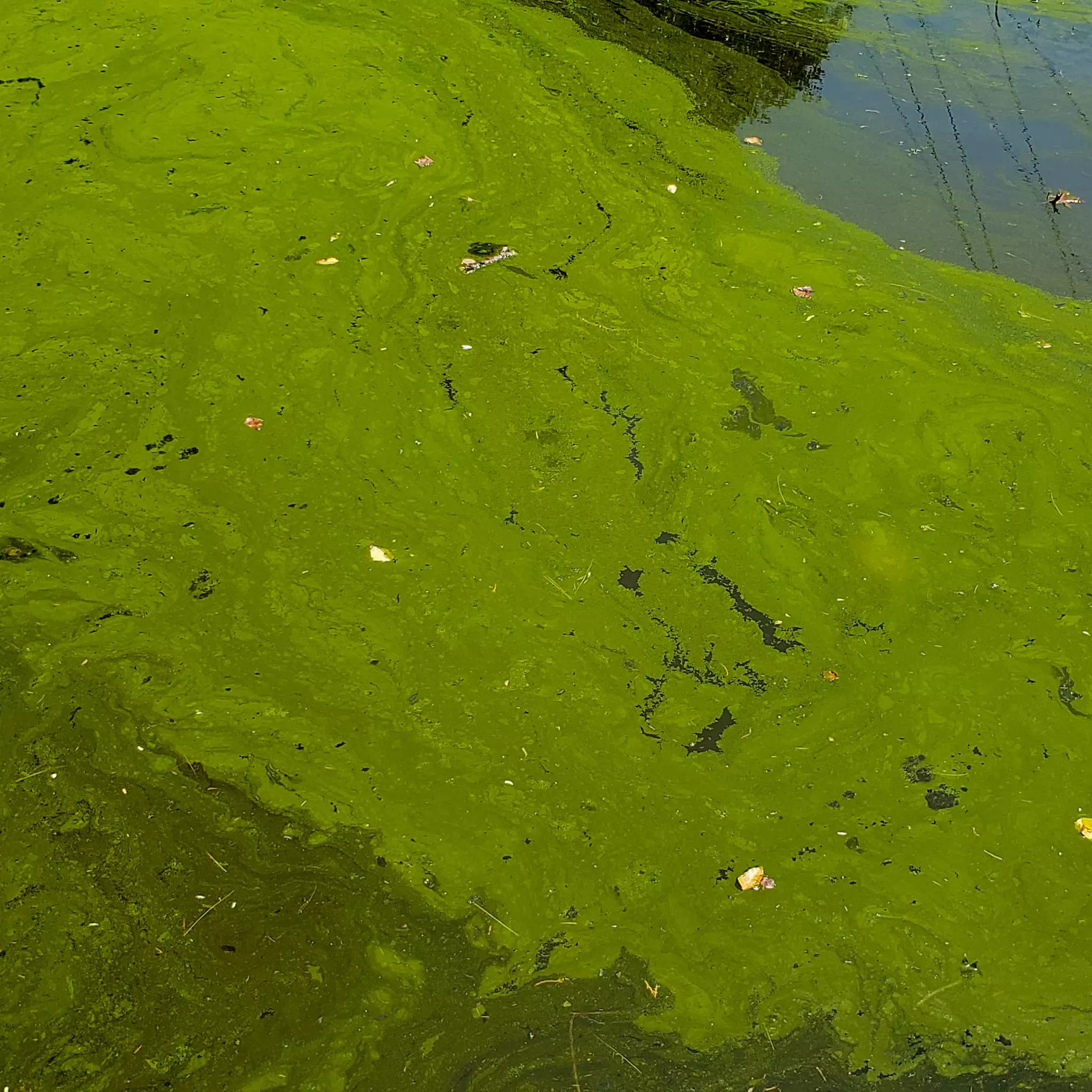
Pond surface possibly containing cyanobacteria. Natalie Auer.
Cyanobacteria are one-celled photosynthetic organisms that normally occur at low levels in surface waters. Under high-nutrient conditions, cyanobacteria can multiply rapidly. Not all cyanobacterial blooms are toxic, but some may release toxins, such as microcystins. Recreational exposure is typically a result of inhalation, skin contact, or accidental ingestion. Health effects of exposure include skin rashes, eye irritation, respiratory symptoms, gastroenteritis, and in severe cases, liver or kidney failure and death. Microcystins are suspected carcinogens. See EPA’s microcystins page for more information. Pets may also be exposed to microcystins if they swim in or drink wetland surface waters, although their risk levels may differ from those that apply to human health.
Microcystin results were compared to the EPA’s recreational water quality criterion and swimming advisory recommendation of 8 parts per billion (ppb) (U.S. EPA 2019).
The NWCA does not capture all risks associated with cyanobacteria. Note that some types of algae and cyanobacteria release other toxins not monitored as part of the NWCA. Also, the NWCA assesses risk of exposure to microcystins at national and regional levels. For information about risks at specific locations, recreational water users should check with state, tribal, or local governments.
Nationally, microcystins were detected in 8% of wetland area in 2016. Regionally, the detection of microcystins ranged from 1% to 24%. Levels exceeded EPA’s recommended water quality criterion in less than 1% of wetland area, as shown below. A total of 42% of wetland area was not assessed due to insufficient surface water for sample collection or due to laboratory issues. Due to improvements in sample collection protocols, the area assessed in 2016 changed compared to 2011. Comparison between 2011 and 2016 is not presented for microcystins because it is not possible to determine whether changes are related to the increase in area assessed or an actual change in condition.
Associations Between Stressors and Wetland Condition
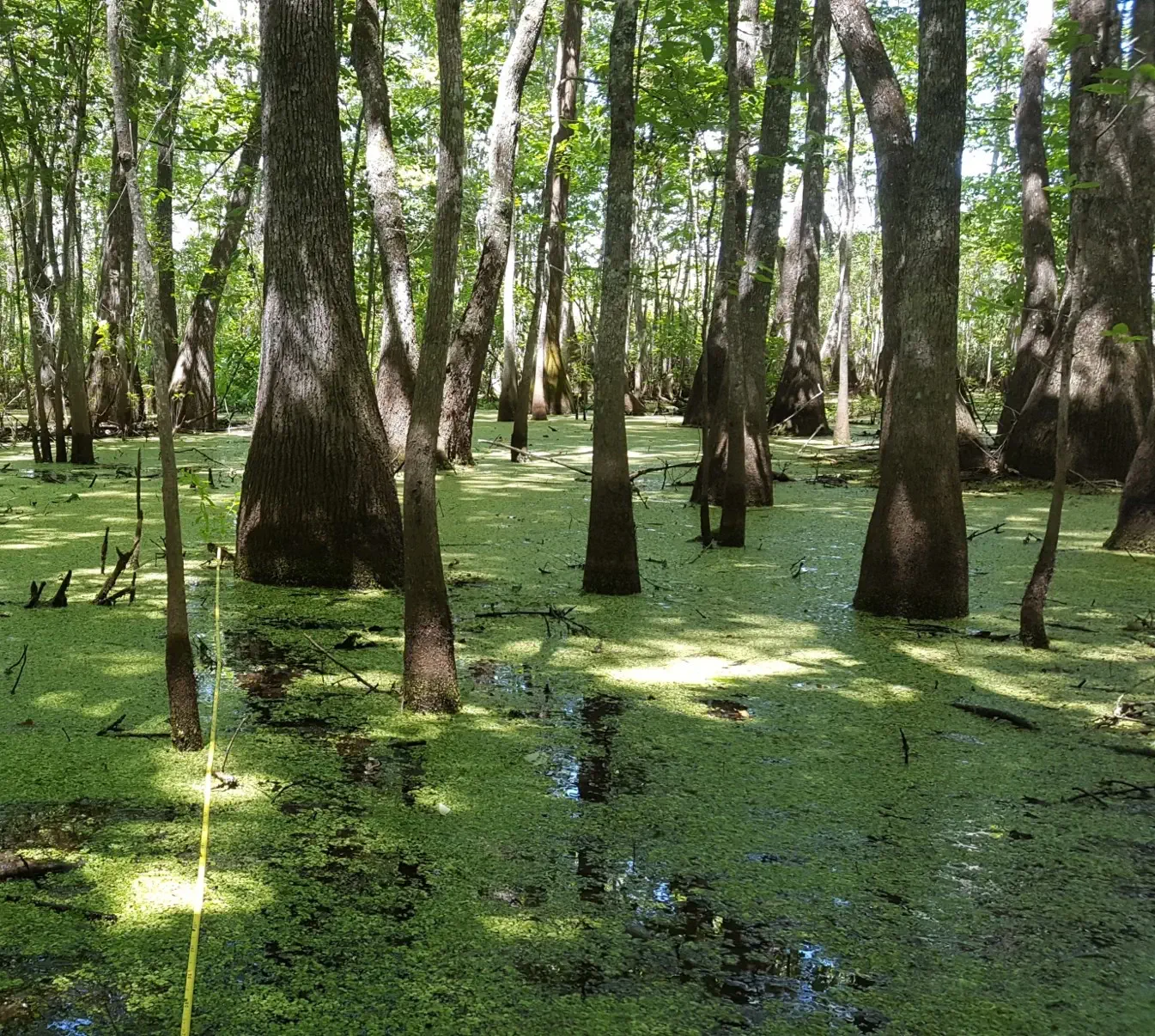
An inland woody wetland in Florida. University of Florida.
Restoring wetland quality requires not only an understanding of current condition and change over time, but also of stressors associated with degraded wetland condition and the extent to which reducing those stressors could improve conditions. This knowledge can help decision makers prioritize stressors for reduction.
Stressors for the NWCA included the chemical and physical measures characterized by the indicators in the previous section. At the national and regional level, EPA performed three calculations for each stressor, using the vegetation MMI as the biological indicator of wetland condition. EPA conducted a similar analysis using the nonnative plant indicator.
- EPA determined the extent of wetland area in poor condition for each stressor (the relative extent).
- EPA then evaluated the extent to which poor wetland condition was more likely when a stressor or indicator was rated poor (the relative risk).
- EPA assessed the potential improvement that could be achieved by reducing or eliminating the stressor (the attributable risk).
Highlights of the national results on risk for the vegetation MMI are described below. Visit the NWCA dashboards to explore risk results nationally and for selected survey subpopulations. For more information on these analyses, visit the NARS risk page.
The NWCA stressors with the highest relative extent nationally were the physical alteration sum indicator (36%), nitrogen (24%), and phosphorus (22%). These were the most widespread stressors.
Soil heavy metals and phosphorus had relative risks of 2.1 and 2.0, respectively. That is, wetlands with poor ratings for these stressors were about twice as likely to have poor condition based on the vegetation MMI.
Combining the relative extent and relative risk values for each indicator into a single value provides us with attributable risk. Attributable risk is the percentage of wetland area in poor condition, based on the biological indicator, that could be improved (that is, moved into either the good or fair category) if the stressor condition were improved from poor.
Exhibit 31 shows that reducing the area in poor condition due to phosphorus in wetland waters could result in the greatest benefit to wetland condition nationally, where wetland condition is based on the vegetation MMI. This exhibit shows attributable risk (including point estimates and 95% confidence intervals) for each stressor with risk values above zero. If wetland area rated poor for phosphorus were improved to fair or good, a 27% reduction in poor condition based on the vegetation MMI could occur. For nitrogen, the reduction in poor condition based on the vegetation MMI could be 23%. Regional attributable risk estimates may vary from the national estimates given the differences in relative extent and relative risk results for different survey subpopulations (see the dashboard).
Calculating attributable risk involves several assumptions, including: 1) that a causal relationship between stressors and wetland condition exists (with wetland condition determined using the biological indicator); 2) that negative effects would be reversed if the stressor were improved to fair or good levels in wetlands in poor condition; and 3) that the stressor’s impact on a wetland’s condition is independent of other stressors. Despite these limitations, attributable risk can provide general guidance as to which stressors might be higher priorities for management nationally.
Attributable Risk from Exposure to Stressors Nationally (2016)
Reducing nutrient pollution, especially phosphorus, in wetlands would have the greatest impact on wetland vegetation nationally. Many wetland plants are adapted to specific nutrient concentration ranges. Increased nutrient levels could decrease plant species diversity or decrease area covered by sensitive species.
Using the nonnative plant indicator as another biological indicator of wetland condition, EPA found that relationships between poor wetland condition and stressors were similar and, in some cases, more pronounced than between the vegetation MMI indicator and stressors. Soil heavy metals and phosphorus showed the highest relative risk. That is, wetlands with poor ratings for these stressors were almost three times more likely to have a rating of poor condition based on the nonnative plant indicator.
EPA calculated that reducing phosphorus in wetland waters could result in the greatest benefit to wetland condition nationally, based on the nonnative plant indicator, as shown in Exhibit 32. If poor phosphorus condition were improved to fair or good, a 40% reduction in poor wetland condition could occur. For nitrogen and the combined physical alteration indicator, the reduction in poor condition could be 21% and 20%, respectively. Only risk values greater than zero are shown in the graph.
Attributable Risk from Exposure to Stressors Nationally (2016)
Some nonnative species are tolerant of a wide range of nutrient levels, allowing them to outcompete native species adapted to low nutrient levels. Reducing nutrient levels, particularly phosphorus, could reduce the amount of wetland area rated poor for the nonnative plant indicator.
To see graphs for relative extent, relative risk, and attributable risk together, visit the "Risk Estimates" section of the NWCA dashboard.
Conclusion
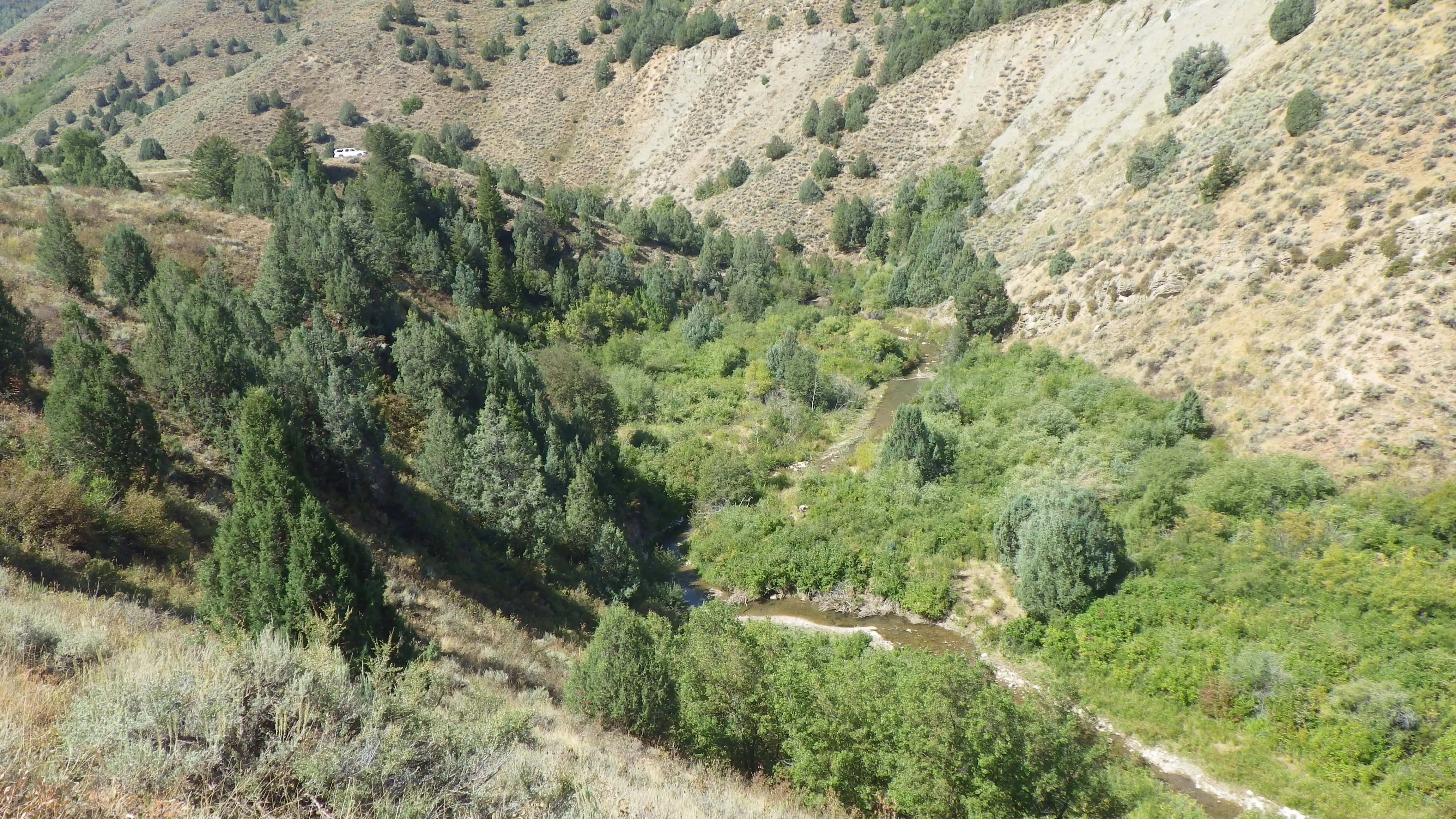
A wooded wetland in a stream valley in Utah, viewed from above. Utah Department of Environmental Quality.
The NWCA provides findings that wetland managers can use to inform resource management priorities and strategies. Nationally, 47% of wetland area was in good condition as measured by the vegetation MMI. Using the nonnative plant indicator, 57% of area was in good condition. The most widespread stressors were the combined physical alteration indicator, nitrogen, and phosphorus, rated poor in 36%, 24%, and 22% of wetland area, respectively. There was little change between surveys for the vegetation MMI, nonnative plants, and the combined physical alteration indicator at the national level.
While the survey results provide national and regional estimates of wetland condition, they do not address all information needs at all scales. For example, the survey does not measure all stressors and cannot be used to infer local condition. In-depth monitoring and analysis of individual wetlands and watersheds are required to support local restoration and protection efforts.
EPA and its state and tribal partners are continually refining the NWCA and will apply lessons learned to determine the need for changes to the design, indicators, field methods, laboratory methods, and analysis procedures for the future. Sampling for the third NWCA took place in the summer of 2021, and sampling for the fourth will take place in 2026.
The NWCA 2016 would not have been possible without the involvement of state and tribal scientists and resource managers. EPA will continue to help state and tribal partners translate the expertise gained through these national surveys to studies of their own waters. Additionally, EPA will support the use of the NWCA data to evaluate the success of efforts to protect and restore water quality.
Other National Aquatic Resource Surveys
In addition to the NWCA, the NARS program also includes the following surveys:
- The National Coastal Condition Assessment (2005, 2010, 2015, and 2020).
- The National Lakes Assessment (2007, 2012, 2017, and 2022).
- The National Rivers and Streams Assessment (2008-09, 2013-14, and 2018-19).
Reports on surveys through 2018-19 are available at the NARS home page. EPA will post additional reports and data as they become available.
About This Report
This report was initially published in April 2023. In January 2024, the soil heavy metals section was changed to correctly characterize the threshold used to determine if sites were in good condition: i.e., that no more than one of the 12 metals could exceed the benchmark. The initial version of the report stated that sites could only be assigned a rating of good condition if none of the 12 metals exceeded the benchmarks.
Any further corrections or updates to the final report will be described in this section.
A suggested citation for the report is provided below:
U.S. Environmental Protection Agency. 2024. National Wetland Condition Assessment: The second collaborative survey of wetlands in the United States. EPA 841-R-23-001. U.S. Environmental Protection Agency, Office of Water and Office of Research and Development. https://wetlandassessment.epa.gov/webreport (Original version published in 2023.)
References
Dahl, T.E. 2006. Status and trends of wetlands in the conterminous United States 1998 to 2004. U.S. Department of the Interior, Fish and Wildlife Service. https://www.fws.gov/sites/default/files/documents/Status-and-Trends-of-Wetlands-in-the-Conterminous-United-States-1998-to-2004.pdf
U.S. Environmental Protection Agency. 2016. National Wetland Condition Assessment 2016: Field operations manual. V1.1a. EPA-843-R-15-007. U.S. Environmental Protection Agency, Office of Water. https://www.epa.gov/sites/default/files/2017-08/documents/nwca2016_fom_v1_1a_full_0.pdf
U.S. Environmental Protection Agency. 2019. Recommended human health recreational ambient water quality criteria or swimming advisories for microcystins and cylindrospermopsin. EPA 822-R-19-001. U.S. Environmental Protection Agency, Office of Water, Health and Ecological Criteria Division. https://www.epa.gov/sites/production/files/2019-05/documents/hh-rec-criteria-habs-document-2019.pdf
U.S. Environmental Protection Agency. 2023. National Wetland Condition Assessment 2016: Technical support document. EPA 841-B-23-001. U.S. Environmental Protection Agency, Office of Water and Office of Research and Development. https://www.epa.gov/national-aquatic-resource-surveys/national-wetland-condition-assessment-2016-technical-support
U.S. Fish and Wildlife Service. 2014. National Wetlands Inventory. U.S. Department of the Interior, Fish and Wildlife Service. https://www.fws.gov/program/national-wetlands-inventory
World Health Organization. 2003. Guidelines for safe recreational water environments. Volume 1, coastal and fresh waters. https://apps.who.int/iris/handle/10665/42591
Appendix: Changes to the NWCA Since 2011
Although many aspects of the survey remained the same in 2016, EPA implemented some improvements for this iteration of the survey and report. This appendix describes changes since NWCA 2011. They include changes to the survey design, indicators, benchmarks, and the way survey results are calculated.
SURVEY DESIGN
EPA adjusted the survey design used for 2016. In 2011, the survey design sample frame (the set of wetlands from which the survey sample was drawn) was based solely on mapped wetland data from the U.S. Fish and Wildlife Service’s (FWS) wetland status and trend survey (Dahl 2006). In 2016, the sample frame was broadened to include additional mapped wetland data obtained from the FWS National Wetlands Inventory (U.S. FWS 2014). This change was made to increase the representation of sites in the western United States and reduce the number of sites near one another (that is, improve geographic coverage) in other parts of the country. See the NWCA 2016 Technical Support Document (U.S. EPA 2023) for further details. This impacted the distribution and types of wetlands sampled across the nation and regionally, which should be considered when evaluating change between 2011 and 2016 for some regional subpopulations.
Another change in 2016 was the way the results from the 967 sampled wetland sites were used to estimate the condition of a larger population of wetlands. For the 2016 report, the site weights used to calculate the condition estimates (percentages) for a given indicator were adjusted for the full target population (95,694,241 wetland acres) as described in the section on selecting wetlands. In 2011, the site weights were adjusted for the subset of the target population that could be sampled. See the Technical Support Document for further details.
INDICATORS
For NWCA 2016, EPA did not report on one indicator included in the 2011 report and added two others, as described below:
- Soil Phosphorus. The NWCA 2011 report contained results for phosphorus concentrations in soil. EPA decided not to report this indicator for 2016 because natural soil phosphorus background levels vary widely across wetland soil types sampled in the NWCA, making it difficult to develop benchmarks for phosphorus that reflect stress to wetland condition. EPA will continue to research and explore development of indicators more effective at assessing nutrient enrichment in wetland soils. Raw data for soil phosphorus are available on the NARS data page.
- Total Nitrogen and Total Phosphorus in Water. EPA introduced two new indicators for 2016 based on surface water measurements of total nitrogen and phosphorus. EPA collected data for these indicators in 2011 but did not include them in the 2011 report.
EPA updated field protocols for several indicators between 2011 and 2016, described below. These indicators all showed significant changes in the wetland area assessed for 2016. Because it is not possible to determine whether changes between surveys were related to the protocol changes or to actual changes in condition, EPA did not include estimates of change for these indicators in this report.
- Total Nitrogen, Total Phosphorus, and Microcystins. In 2011, crews were instructed to collect water samples if surface water was at least 15 centimeters deep. In 2016 this requirement was relaxed, and there was no minimum depth requirement.
- Soil Heavy Metal Indicator. In 2016, crews collected the top 10 centimeters of soil for their samples. In 2011 the samples were based on the thickness of the topmost soil layer, or horizon, which was sometimes more or less than 10 centimeters.
EPA updated how several indicators are calculated in 2016, as described below. For details on these changes, see the Technical Support Document.
- Vegetation Multimetric Index. In 2011, a single vegetation MMI applicable across the national scale of the conterminous United States was developed and employed in assessing wetland condition. For 2016, the combined number of wetland sites sampled in the 2011 and 2016 NWCAs provided sufficient data to allow development of separate MMIs for each of four major wetland groups: estuarine herbaceous, estuarine woody, inland herbaceous, and inland woody.
- Physical Alterations. In 2011, EPA categorized physical disturbance by assigning each observed disturbance to one of six indicators based on whether it represented an alteration to vegetation or hydrology. For 2016, EPA adjusted how it categorized the disturbance data and calculated the physical alteration indicator scores. There continue to be six indicators, but they are now categorized by alterations to vegetation, hydrology, and soil, the three main components of a wetland. The method for calculating scores for each indicator was also revised. In addition, a summary indicator combining results for the six physical alteration indicators was developed.
- Soil Heavy Metal Indicator. In 2011, to calculate the soil heavy metal indicator value, EPA used a simple index that summed the number of heavy metals that exceeded background concentrations cited in published literature. For 2016, EPA used a combination of the number of heavy metals above background level and the maximum enrichment factor of any one metal (the ratio of a metal’s concentration at a site to background concentrations for that metal) to assess condition. (EPA also used a different source for background concentration data; see the next section). The metals analyzed did not change.
BENCHMARKS
Additionally, EPA updated benchmarks for the following indicators in 2016, as described below. For details on the updates, see the Technical Support Document.
- Microcystins. For NWCA 2016, EPA compared microcystins concentrations to the EPA recreational water quality criterion and swimming advisory recommendation (8 ppb) (U.S. EPA 2019). In NWCA 2011, recreation risk results were based on World Health Organization (WHO) guidelines for microcystin (WHO 2003).
- Vegetation Multimetric Index. Because EPA switched from using one to using four vegetation MMIs, as described above, new benchmarks for good, fair, and poor condition were needed for each index. Further, for inland woody wetlands, due to pronounced regional differences, EPA determined that two sets of benchmarks were needed. One set of benchmarks applied to inland woody sites in the Xeric and Interior Plains ecoregions, and the other set applied to the Coastal Plains, Western Mountains, and Eastern Mountains/Upper Midwest ecoregions.
- Soil Heavy Metal Indicator. EPA used soil data collected at NWCA reference wetlands sampled in 2011 and 2016 to set natural background level benchmarks. Soil measurements were evaluated against these benchmarks to assign condition for this indicator. Previously, in 2011, the benchmarks were literature-based.
For this report, EPA recalculated the 2011 results, taking all the changes above into account, to facilitate comparison between the 2011 and 2016 results. The 2011 results presented in this report therefore differ from the results presented in the NWCA 2011 report. Readers wishing to compare 2016 results to 2011 should use this report and the NWCA 2016 dashboard, not the 2011 report.
Acknowledgments and Disclaimer
The EPA Office of Water and EPA Office of Research and Development would like to thank the many people who contributed to this project. Without the collaborative efforts and support by state and tribal environmental agencies, federal agencies, universities, and other organizations, this assessment of wetlands would not have been possible. In addition, the survey could not have been done without the innumerable field biologists, soil scientists, taxonomists, statisticians, and data analysts, as well as program administrators, EPA regional coordinators, project managers, quality control officers, and reviewers. To the many hundreds of participants, EPA expresses its profound thanks and gratitude.
State and Tribal Agency Partners
- Alabama Department of Environmental Management
- Arizona Department of Environmental Quality
- California State Water Resources Control Board
- Colorado Natural Heritage Program
- Confederated Tribes of the Umatilla Indian Reservation
- Delaware Department of Natural Resources and Environmental Control
- Florida Department of Environmental Protection
- Georgia Department of Natural Resources
- Idaho Department of Environmental Quality
- Illinois Environmental Protection Agency
- Illinois Natural History Survey
- Indiana Department of Environmental Management
- Iowa Department of Natural Resources
- Kansas Department of Health and the Environment
- Kansas Water Office
- Kentucky Division of Water
- Leech Lake Band of Ojibwe, Division of Resource Management
- Louisiana Department of Wildlife and Fisheries
- Maine Department of Environmental Protection
- Maine Natural Areas Program
- Maryland Department of the Environment
- Massachusetts Department of Environmental Protection
- Michigan Department of Environment, Great Lakes, and Energy
- Minnesota Pollution Control Agency
- Missouri Department of Natural Resources
- Montana Natural Heritage Program
- Navajo Environmental Protection Agency
- Nebraska Game and Parks Commission
- Nevada Division of Environmental Protection
- New Hampshire Department of Environmental Services
- New Jersey Department of Environmental Protection
- New Mexico Environmental Department
- New Mexico Natural Heritage Program
- New York Natural Heritage Program
- North Carolina Department of Environment and Natural Resources
- North Dakota Department of Health
- Ohio Environmental Protection Agency
- Oklahoma Conservation Commission
- Oregon Department of Environmental Quality
- Oregon Division of State Lands
- Pennsylvania Department of Environmental Protection
- Quinault Indian Nation
- South Carolina Department of Health and Environment Control
- Tennessee Department of Conservation and Environment
- Texas Commission on Environmental Quality
- Utah Department of Environmental Quality
- Utah Geological Survey
- Vermont Department of Environmental Conservation
- Virginia Department of Environmental Quality
- Washington State Department of Ecology
- West Virginia Department of Environmental Protection
- Wisconsin Department of Natural Resources
- Wyoming Department of Environmental Quality
- Wyoming Natural Diversity Database
Federal Partners
- National Park Service
- U.S. Army Corps of Engineers
- U.S. Department of Agriculture, Natural Resources Conservation Service
- U.S. EPA Office of Research and Development
- U.S. EPA Office of Water
- U.S. EPA Regions 1-10
- U.S. Fish and Wildlife Service
- U.S. Forest Service
- U.S. Geological Survey
Additional Collaborators
- ALS Global, Middletown
- Avanti
- Crow Insight
- Eastern Kentucky University
- EnviroScience
- General Dynamics Information Technology
- Great Lakes Environmental Center
- Kenyon College
- Midwest Biodiversity Institute
- Moss Landing Marine Laboratories
- New England Interstate Water Pollution Control Commission
- Nicholls State University
- North Dakota State University
- Oregon State University
- PG Environmental
- Riparia at Pennsylvania State University
- Southern California Coastal Water Research Project
- University of Central Missouri
- University of Florida
- University of Houston-Clear Lake
- University of Illinois
- University of Montana
- University of Nebraska-Lincoln
- University of Wyoming
- Virginia Institute of Marine Sciences
Disclaimer. This report provides information on the quality of the nation’s wetlands. It does not impose legally binding requirements on EPA, states, tribes, other regulatory authorities, or the regulated community. This document does not confer legal rights or impose legal obligations upon any member of the public. This document does not constitute a regulation, nor does it change or substitute for any Clean Water Act provision or EPA regulation. EPA could update this document as new information becomes available. EPA and its employees do not endorse any products, services, or enterprises. Mention of trade names or commercial products in this document does not constitute an endorsement or recommendation for use.
